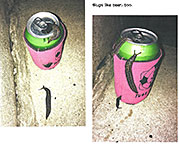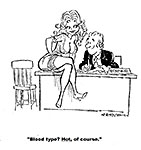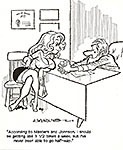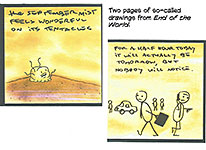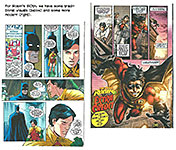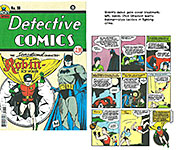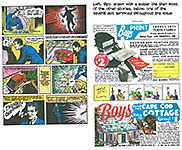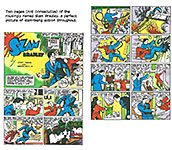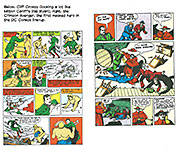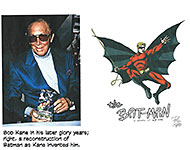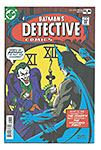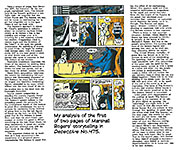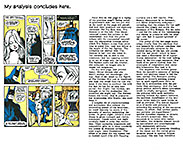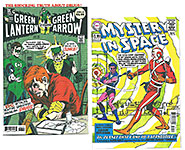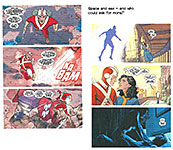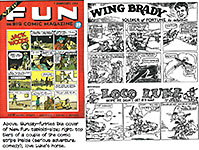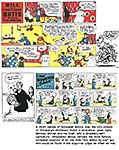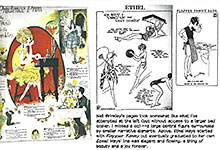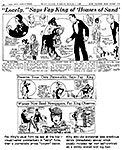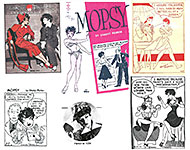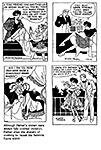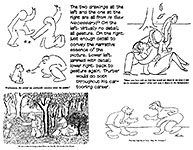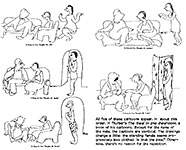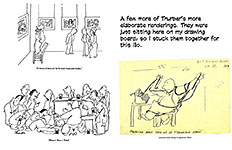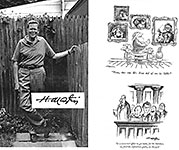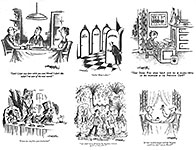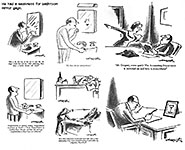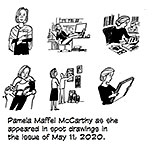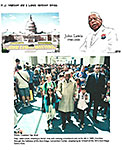 |
|||||||||||||||||||||||||||||||
Opus 406 (August 10, 2020). Once again, we catch up on editorial cartooning by posting a generous selection from the past month (beginning with the Gestapo in Portland and including Mary Trump), plus reviews of books (Screwball, the cartoonists who made the funnies funny; and Flapper Queens, women cartoonists of the jazz age), and several funnybook number ones (Adventureman, Texas Blood, Dead Body Road, and the excellent Family Tree) and facsimiles of comicbooks (Detective No.38, also No.475 and the Very First Comicbook, New Fun), and an old cartoon of mine unearthed. And farewells to Joe Sinnott, Henry Martin, and John Lewis. We’ll list it all in a minute. But before we get to that, there’s this—:
LET’S TAKE A MINUTE TO REMEMBER JOHN LEWIS And the Beloved Community Writing in The Nation (August 10/17, 2020), columnist Elie Mystal said: “My mother was born in 1950 in segregated Mississippi. The first time she met the Rev. Martin Luther King Jr., she was at home after church in the late ’50s when he visited my grandmother and her young family. ... My mother has a living memory of events I’ve only read about. ... The death of John Lewis on July 17 is a national example of what many Black people my age are experiencing personally or will experience soon: the death of living memory.” The
picture hereabouts is a photograph of John Lewis and President Barach Obama
during a walk across Edmund Pettus Bridge to Selma, Alabama, to commemorate the
50th anniversary of the “Bloody Sunday” march from Selma to
Montgomery in 1965. When Obama was inaugurated in 2009 as the nation’s first Black president, he handed Lewis a photo on which he had written “Because of you, John.” When Trump was inaugurated in 2017, Lewis announced that he would not attend, sparking a boycott of the ceremony. John Lewis said a lot of things in his 80 years, and what he said influenced events and people. We’re remembering some of them here; other memories of Lewis are posted at the end of this opus, where his obit would be if we published such a thing about a man who will never die. “If you want to create an open society,” Lewis said, “your means of doing so must be consistent with the society you want to create. Means and ends are absolutely inseparable. Violence begets violence. Hatred begets hatred. Anger begets anger every minute of the day, in the smallest moments as well as the largest.” This concept of love in action was called “soul force” by James Lawson, whose lectures and concepts would have a profound effect on Lews and his classmates at Nashville’s American Baptist Theological Seminary. Lewis wrote: “Both Lawson and Martin Luther King, Jr., knew they were training for a nonviolent struggle that would force this country to face its conscience. ‘Soul force’ would see us through the pain and ugliness that lay ahead ... all in pursuit of something both men called ‘the Beloved Community.’”
“DR. KING AND ROSA PARKS INSPIRED ME to get in trouble—‘good trouble’—necessary trouble to make our country and our world a better place,” said Lewis. “I came to the conclusion that our struggle is not one that lasts for one day, one week, a few months or a few years, but it’s the struggle of a lifetime, of many lifetimes ... if that’s what it takes to build the Beloved Community, to open society.” Lewis remembers the nameless heroes of the civil rights moment. “They were the rank and file in Selma, in Americus, in Little Rock—everywhere. You see their faces today in photographs and history books, and nobody knows their names. That guy sitting stoically at the lunch counter in Jackson ... and a mob of White hoodlums crowded around him taunting and laughing. Who is he? Where is he today? ... Whatever happened to the little girl who was turned head over heels by those fire hoses?” “We cannot give up now ... We must go out and vote like we’ve never, ever voted before. We must use the vote as a nonviolent instrument or tool to redeem the soul of America.” “I don’t want to go back. I want to go forward,” Lewis said. “I want to continue to be part of an effort to make America one when we lay down the burden of race, the burden of hate, and we create one society, one people ... we all live in the same house.” In December 2019, Lewis disclosed that he was being treated for stage 4 pancreatic cancer. “I have been in some kind of fight for freedom, equality, basic human rights—for nearly my entire life,” he said. “I have never faced a fight quite like the one I have now. I’m going to fight it and keep fighting for the Beloved Community. ... We still have many bridges to cross.”
******
AND NOW, To help you in wading through all the plethora of this posting, we’re listing Opus 406's contents below so you can pick and choose which items you want to spend time on. Here’s what’s here, by department, in order (the longest entries are marked with an asterisk*)—:
NOUS R US Far Side Returns Also Beavis and Butt-Head More Cons Postponed Until 2021 Comics and Graphic Novel Sales Top $1.2 Billion Walmart Censors Superheroine Costumes Whites No Longer Voice Characters of Color Garrison’s Faucet Spoof Scholastic Hopes to Rebound Financially from Q4 Slump Diamond Gets Government Loans Stan Lee Goes On and On and On Odds & Addenda Geppi’s Back Rorschach To Come CBLDF Anthology In Question Sakai’s Usagi Yojimbo To Be Animated
FUNNYBOOK FAN FARE Adventureman, No.1 Family Tree, Nos.1-5 Dead Body Road: Bad Blood, No.1 That Texas Blood, No.1 Dark Nights Death Metal: Ready for the Encore, No.1 Rounding Up a Few Strays—: Butcher of Paris, No.5 Moonshine, No.18 Decorum, No.2
* MORE RANT THAN RAVE A Few Well-Chosen Words on the Passing Controversies—: Reopening Bars Hikers Must Buy Hunting Licenses Sacrilegious Beer Hamburger Chain and Climate Control Desecrating the Vietnam Memorial
TRUMPERIES * The Antic Idiocies of the Self-Indulgent Narcisstic Buffoon in Chief Mary Trump’s Book about Her Uncle
EDITOONERY The Gestapo in Portland and Other News
* Anemic Choices Newspapers Make With Editorial Cartoons
NEWSPAPER COMICS PAGE VIGIL The Bump and Grind of Daily Stripping—: Only in the Comics Favorite Beetles
Slugs and Beer and My Illinois Daughter
RANCID RAVES GALLERY Two Toons From My Magazine Cartooning
BOOK MARQUEE End of the World (Stick Figures—ugh) FACSIMILES Robin: 80th Anniversary Detective Comics, No.38 (Creating Batman, Kane and Finger) *Detective Comics, No.475 (My Comics Journal Debut) Green Lantern Green Arrow, No.85 Mystery in Space, No.75 New Fun, No.1—The Big Comic Magazine
BOOK REVIEWS * Screwball! The Cartoonists Who Made the Funnies Funny * Flapper Queens: Women Cartoonists of the Jazz Age
COLLECTORS’ CORNICHE Gladys Parker’s Mopsy More James Thurber
PASSIN’ THROUGH Joe Sinnott Henry Martin John Lewis
QUOTE OF THE MONTH If Not of A Lifetime “Goddamn it, you’ve got to be kind.”—Kurt Vonnegut
Our Motto: It takes all kinds. Live and let live. Wear glasses if you need ’em. But it’s hard to live by this axiom in the Age of Tea Baggers, so we’ve added another motto: Seven days without comics makes one weak. (You can’t have too many mottos.)
And in the same spirit, here’s—: Chatter matters, so let’s keep talking about comics. AND—
“If we can imagine a better world, then we can make a better world.”
And our customary reminder: don’t forget to activate the “Bathroom Button” by clicking on the “print friendly version” so you can print off a copy of just this installment for reading later, at your leisure while enthroned. Without further adieu, then, here we go—:
NOUS R US Some of All the News That Gives Us Fits
FAR SIDE RETURNS Announced at the DailyCartoonist.com by D.D. Degg on July 7: Gary Larson has returned!! And, in case you missed it, here’s Larson himself, explaining—: “I don’t want to mislead anyone here. This corner of the website—‘New Stuff’—is not a resurrection of The Far Side daily cartoons. (Well, not exactly, anyway—like the proverbial tiger and its stripes, I’m pretty much stuck with my sense of humor. Aren’t we all?) The thing is, I thoroughly enjoyed my career as a syndicated cartoonist, and I hope, in spirit at least, we had some laughs together. But after fifteen years of meeting deadlines, well, blah blah blah … you know the rest. The day after I retired from syndication, it felt good not to draw on a deadline. “And after moving on to other interests, drawing just wasn’t on my to-do list. Things change. But then a few years ago—and returning to the subject at hand—-something happened in my life, and it started with a clogged pen. “Despite my retirement, I still had intermittent connections to cartooning, including my wife’s and my personal Christmas card. Once a year, I’d sit myself down to take on Santa, and every year it began with the same ritual: me cursing at, and then cleaning out, my clogged pen. (Apparently, the concept of cleaning it before putting it away each year was just too elusive for me.) “As problems go, this is admittedly not exactly on the scale of global warming, but in the small world of my studio, it was cataclysmic. Okay, highly annoying. “So a few years ago—finally fed up with my once-loyal but now reliably traitorous pen—I decided to try a digital tablet. I knew nothing about these devices but hoped it would just get me through my annual Christmas card ordeal. “I got one, fired it up, and lo and behold, something totally unexpected happened: within moments, I was having fun drawing again. “I was stunned at all the tools the thing offered, all the creative potential it contained. I simply had no idea how far these things had evolved. Perhaps fittingly, the first thing I drew was a caveman. “The ‘New Stuff’ that you’ll see here is the result of my journey into the world of digital art. Believe me, this has been a bit of a learning curve for me. I hail from a world of pen and ink, and suddenly I was feeling like I was sitting at the controls of a 747. (True, I don’t get out much.) “But as overwhelmed as I was, there was still something familiar there—a sense of adventure. That had always been at the core of what I enjoyed most when I was drawing The Far Side, that sense of exploring, reaching for something, taking some risks, sometimes hitting a home run and sometimes coming up with ‘Cow tools.’ (Let’s not get into that.) But as a jazz teacher once said to me about improvisation, ‘You want to try and take people somewhere that they might not have been before.’ “I think that my approach to cartooning was similar—I’m just not sure if even I knew where I was going. But I was having fun. “So here goes. I’ve got my coffee, I’ve got this cool gizmo, and I’ve got no deadlines. And—to borrow from Sherlock Holmes—the game is afoot. “Again, please remember, I’m just exploring, experimenting, and trying stuff. New Stuff. I have just one last thing to say before I go: thank you, clogged pen.” —Gary Larson
AND, SPEAKING OF RETURNS— Joe Otterson at variety.com reports that Beavis and Butt-Head are returning to tv. Comedy Central announced lately that the world’s favorite slacker teens are getting a reimagining at the cable network courtesy of original series creator Mike Judge. Comedy Central has ordered two seasons of the show as part of a new animation deal with Judge and 3 Arts Entertainment. The deal also includes potential spin-offs and specials. As with the original series, Judge is set to write, produce and provide the voices for both iconic characters. I wonder where Rick Parker, who drew the characters for a while in comicbooks, figures is in this deal.
THE DOMINOS CONTINUE TO FALL Two more major regional geek culture conventions have been cancelled for 2020, creating nearly a clean sweep of cancellations for the year, reports Milton Griepp at ICv2— “we’re looking at you, New York Comic Con.” (New York Comic Con is still slated for October 8-11. “Not even the Covid-19 pandemic could stop this pop culture juggernaut,” boasts the Con.) Wizard Entertainment "postponed" its 2020 Chicago event to 2021, with dates earlier in the summer than usual for the show: June 24-27, 2021. Wizard’s Chicago convention is its largest and longest-running show, with roots back to the earliest days of comic conventions. Other 2020 Wizard events were canceled earlier in the year. Wizard has also announced dates for several other 2021 events: New Orleans: January 8-10; Philadelphia: January 15-17; Portland: January 29-31; Cleveland: February 26-28; St. Louis: March 12-14; Chicago: June 24-27. And in a sign that even when organizers try to plan live events that take the coronavirus pandemic into account, it’s going to be difficult to pull them off, Informa division Fan Expo HQ has canceled plans for MegaCon Limited Edition, which was scheduled for October 30 - November 1. The plan was for a show that hosted only about 25% of its usual attendees: 25,000 instead of 100,000, a lower-density event that would allow for social distancing. Now the organizers said that "…it has become increasingly clear over the past few weeks that this is not a viable option." The next MegaCon event is now planned for March 18-21.
COMICS AND GRAPHIC NOVEL SALES TOP $1.2 BILLION IN 2019 By Calvin Reid at publishersweekly.com. Driven by continued growth in popularity of the graphic novel format, combined sales of graphic novels and periodical comics in the U.S. and Canada totaled roughly $1.21 billion in 2019, according to a joint estimate produced by trade news sites ICv2 and Comichron, representing an 11% increase over total comics and graphic sales in 2018. The increase in sales was led by the graphic novel book format, in particular continued growth in sales of children's graphic novels, sold via the bookstore channel, which includes chain bookstores, online retailers, mass market stores, and Scholastic Book Fairs. And while the book format led sales growth overall, sales of periodical comics in the comics shop market were also up by about 5%. "The massive shift to graphic novels as the preferred format for comics continued in 2019, bringing sales in the book channel above the comic store channel in North America for the first time in the history of the medium," ICv2 CEO Milton Griepp said of the findings. In 2019, North American sales of the graphic novel format were about $765 million, while sales of periodical comics were about $355 million, with sales of digital comics at about $90 million. ... Speaking to the findings, Comichron owner Jonathan Miller took note of the Covid-19 pandemic and said it will undoubtedly impact 2020 sales. "The comics industry has displayed resilience during many difficult times over the decades," he said. "While the pandemic may prove its biggest test yet, 2019 provided the business with a strong base."
WALMART/DC COMICS CENSORED SUPERHEROINES By Rich Johnston, bleedingcool.com The recent DC Giant-Sized Superman Nos.9 and 10, exclusive (for now) to Walmart has been reprinting classic stories, but has also been bowdlerising them a little for the modern Walmart audience. What was once acceptable, for some reason, is no longer kosher. Especially when it comes to how the late Michael Turner drew women. Rather, the clothes he drew on women. Or not, as the case may be. So in these reprinted issues of Superman/Batman by Jeph Loeb and Michael Turner, chosen especially by DC Comics for these Walmart comic books, we have DC Comics character Artemis, sporting a rather specific asymmetrical look on Paradise Island, where she is hanging out with the other Themyscirians. Well, one bit of her seems to be hanging out more than the others.
WHITES NO LONGER VOICING CHARACTERS OF COLOR By Sonia Rao at washingtonpost.com ‘The Simpsons’ and ‘Big Mouth’ are recasting nonwhite roles. But it’s about more than finding the right voices. “Big Mouth” star Jenny Slate was the first white actor to publicly announce she would no longer voice a mixed-race character, followed shortly by Kristen Bell of “Central Park.” Mike Henry soon after tweeted that he would stop voicing Cleveland, a black character who has long existed in the “Family Guy” universe. Months after Hank Azaria stepped down from voicing Indian store clerk Apu Nahasapeemapetilon on “The Simpsons,” producers said white actors would refrain from voicing nonwhite characters across the board. The cascade of regrets flowed out over the course of a few days — a tight time frame, taking into account the years of skepticism directed toward this casting dynamic. As protests in support of black lives continue to spark conversations about how black people are treated in professional spaces, there’s a sense of urgency driving attempts at solidarity. “I can’t change the past,” Slate wrote on Instagram, “but I can take accountability for my choices. I will continue to engage in meaningful anti-racist action.” These white actors have been commended by many for doing their part to create space for black artists. The landscape is different for voice actors, who work in what actress Joan Baker refers to as a “behind-the-scenes industry.” Actors who don’t appear on-screen are technically able to play characters of any race. For this reason, cross-racial casting hasn’t always been frowned upon; the attention paid to persisting imbalances in opportunity for artists of color, however, increasingly makes it so. Equitable casting “is being demanded to the point where people are giving up their jobs they’ve had for 20 years,” Baker says. “In a sense, I think it’s a great thing to have opportunity for diversity to come into place and be the norm. Why? Because it reflects the world. The world isn’t just one-sided.”
GARRISON’S FAUCET SPRUNG A LEAK Right-wing
editoonist Ben Garrison's cartoons have become so controversial that he was
banned from attending the White House's summit on social media in July of last
year. Garrison's drawing mocking Dr. Anthony Fauci as a leaking faucet was
shared on Facebook by White House deputy chief of staff Dan Scavino, who is the
director of social media for the administration, amid a war of words the White
House was waging on the infectious disease expert. The cartoonist, based in Montana, self-identifies as Libertarian but he's become a favorite of the alt-right and groups like Q-Anon, which promote conspiracy theories about the 'deep state' working against President Donald Trump. The group also promotes the baseless theories that Jews control the government, the coronavirus is overstated and scientists are looking to control and track people through vaccines. Its theories thrive online and on social media as tech companies come under pressure to police the content on their platforms. Garrison's cartoons reflect many of these themes but he denies being a racist. His cartoons - many of which lionize President Trump as a buff, super-hero type figure - have drawn fans and detractors alike.
SCHOLASTIC LOOKS TO REBOUND FROM Q4 SLUMP By Jim Milliot at publishersweekly.com The Covid-29 pandemic dropped revenue by $187 million, or almost 40%, in the fourth quarter of fiscal 2020, at Scholastic, leading to a 10% decline in sales for the year ended May 31, 2020, compared to fiscal 2019. Revenue ended fiscal 2020 at $1.49 billion. The fourth quarter slump also resulted in an operating loss of $46.2 million in the most recent quarter, compared to a profit of $32 million in the final period of fiscal 2019. The fourth quarter, Scholastic noted, is when the company typically records the majority of its earnings and cash flow, but with the decline in results, the publisher had an operating loss of $88.5 million for the full year, compared to earnings of $25 million a year ago. ... The pandemic struck at a time when Scholastic was preparing to mark its 100th anniversary, as the company published its first magazine in October 1920. “For all those years teachers and schools and parents have looked to Scholastic to help them engage children in reading and learning,” Robinson, whose father started Scholastic, said, “facing the difficulties of this year's return to school, Scholastic's help has never been more necessary than it is right now.”
DIAMOND GETS GOVERNMENT LOANS The rough amounts of the loans received by Diamond companies under the Payment Protection Program were revealed by the Small Business Administration as part of a major data dump on the recipients of the PPP loans. Geppi Family Enterprises CEO Steve Geppi told ICv2 in an interview in May that GFE had received some money from the program, but the amount had not previously been known. A loan for Diamond Comic Distributors, Inc. in the range of $5-$10 million was approved on April 10; while a loan for Diamond Select Toys & Collectibles LLC in the range of $150,000-$350,000 was approved on May 1. A loan to sister company Rosebud Entertainment, LLC, which published Baltimore magazine, for $350,000 - $1 million, was approved on April 30. PPP loans are forgivable if at least 60% of the money goes to payroll expense.
STAN LEE GOES ON AND ON AND ON Genius Brands International and Stan Lee’s POW! Entertainment have formed Stan Lee Universe, a joint venture, which will hold the worldwide rights to Stan Lee’s name, physical likeness and signature, and creations in perpetuity, the companies announced. According to ICv2.com, Genius Brands will manage and control the joint venture. The rights include 100 previously unexploited post-Marvel properties, from which Genius plans to develop and license approximately seven properties per year. Genius Brands was already in business on one Stan Lee property, Stan Lee’s Superhero Kindergarten animated series (with Arnold Schwarzenegger) recently acquired by Amazon Prime. Genius’ best-known property is Baby Genius. The deal comes just after a lawsuit filed against POW! by Lee’s daughter JC last year was dismissed, POW! announced. The judge sanctioned JC Lee $1,000,000 and her law firm $250,000. The suit, adjudged frivolous, had alleged that "the rights to Stan Lee’s intellectual property had been looted, muddied and entangled by POW! and a range of bad actors enabled by POW!"
ODDS & ADDENDA Geppi Family Enterprises Chairman and CEO Steve Geppi is reassuming the role of President, as current Chief Operating Officer Stan Heidmann departs, reports Milton Griepp at ICv2.com. Heidmann assumed the role of President from Geppi when he joined the company last year. Geppi wished Heidmann the best. “I thank him for his contributions and wish him all the best in his future endeavors,” Geppi said in a letter to employees, vendors, and retailers. Geppi said the move “…will help us lean even further into the many opportunities to elevate our industry, our business and our brands in this fast- moving and evolving marketplace.” DC will launch a new 12-issue maxiseries in October by Tom King (Mister Miracle) and Jorge Fornés (Batman), together delivering a new vision of one of the most riveting characters from Watchmen—a figure in a fedora and a trench coat, loved by some, reviled by others— Rorschach. The Free Comic Book Day anthology from CBLDF and Boom! Studios has an uncertain future. In the wake of the scandal involving CBLDF Executive Director’s resignation, several creators who worked on the anthology have told Newsarama that they have asked their material to be withdrawn from the project— or that the anthology be destroyed completely. Seems like throwing out the proverbial baby with the bathwater to me. The world of Stan Sakai’s iconic Usagi Yojimbo comic books is coming to television for the first time in an animated series entitled “Samurai Rabbit: The Usagi Chronicles.” Rather than centering around the comic books’ protagonist Miyamoto Usagi, the series will take place in the far future and follow the teenage Rabbit Samurai Yuichi, descendent of the aforementioned great warrior, on his epic quest to become a true samurai. Sakai will serve as an executive producer on the show.
Fascinating Footnit. Much of the news retailed in the foregoing segment is culled from articles indexed at https://www.facebook.com/comicsresearchbibliography/, and eventually compiled into the Comics Research Bibliography, by Michael Rhode, who covers comic books, comic strips, animation, caricature, cartoons, bandes dessinees and related topics. It also provides links to numerous other sites that delve deeply into cartooning topics. For even more comics news, consult these three other sites: Mark Evanier’s povonline.com, Alan Gardner’s DailyCartoonist.com (now operated without Gardner by AndrewsMcMeel, D.D. Degg, editor); and Michael Cavna at voices.washingtonpost.com./comic-riffs . For delving into the history of our beloved medium, you can’t go wrong by visiting Allan Holtz’s strippersguide.blogspot.com, where Allan regularly posts rare findings from his forays into the vast reaches of newspaper microfilm files hither and yon.
FURTHER ADO I started out with nothing, and I still have most of it.
FUNNYBOOK FAN FARE Four-color Frolics An admirable first issue must, above all else, contain such matter as will compel a reader to buy the second issue. At the same time, while provoking curiosity through mysteriousness, a good first issue must avoid being so mysterious as to be cryptic or incomprehensible. And, thirdly, it should introduce the title’s principals, preferably in a way that makes us care about them. Fourth, a first issue should include a complete “episode”—that is, something should happen, a crisis of some kind, which is resolved by the end of the issue, without, at the same time, detracting from the cliffhanger aspect of the effort that will compel us to buy the next issue. A completed episode displays decisive action or attitude, telling us that the book’s creators can manage their medium.
ANY COMICBOOK drawn by Terry Dodson and inked by his wife Rachel is bound to be beautifully done. And Adventureman, No.1 is that, beautifully done. It is otherwise an unholy mess. It pits Adventureman and his six compadres against the Baron and Baroness Bizarre and their four minions. Not only does the story immediately get overwhelmed by a too numerous cast, but the title character disappears from the action often, leaving us to wonder, “What the shit?” Then suddenly, halfway through the book, the whole thing changes. We’re in a different time, different place, and we meet Claire, a beautiful woman who is hard of hearing, and her 10-year-old imaginative son, Tommy—and Claire’s family, six sisters and her grizzled father. Adventureman and all those other characters, each with a particular superpower, disappear—or, perhaps, are only characters in a book that Tommy has been reading, a book he picked up at his mother’s bookshop. In the last pages of the book, we see Claire sleeping, a scene that continues—exactly the same—for several pages as her bedroom is invaded by buzzing flying bugs. And that’s just the story, conjured up by Matt Fraction. Then we have Terry Dodson’s storytelling. Beautiful drawings, but bad storytelling. Too many panels of hardware, and too many panels in which the characters are drawn very, very tiny. We can tell who they are from what they say—not from what we see, because they are too small to be seen. Those panels are accompanied by other panels depicting heroines in extreme close-up.
In the Adventureman section of the book, we have a lot of action beautifully illustrated. But we don’t know why everyone is fighting. Just because heroes always fight villains? In Claire’s section of the book, no action particularly, but by varying camera distance and angle, Terry creates visual excitement that is virtually the same as action. Claire’s bookshop is visited by a couple strange characters—a beautiful woman in elaborate 17th century costume, and a black fuzzy monster that Claire kicks to pieces, the pieces turning into buzzing insects. In a long 6-page section at the back of the book, Fraction tells us about how he conceived of this stuff—the concept, the characters, etc.—illustrated by Dodson sketches of the characters evolving. There, we find out that Claire is the central character. There are a couple completed episodes in the book, but they are indecisive and cannot rescue the story, which is too full of mystery and inexplicable events. But I’ll buy the next issue for the Dodsons. If there is another issue. The Dodsons produced a comicbook entitled Red One several years ago. It went to three issues and then disappeared. It later re-appeared and ran for another issue, and then several issues were published together. But I never heard of them so I assumed Red One never finished. Red One suffered from many of the same storytelling faults we see in Adventureman. But it was beautiful.
FAMILY TREE is about a family that is turning into trees. The father, Darcy, has already turned, and as we make the acquaintance of the family—wife Loretta, son Josh, daughter Megan—the daughter is showing signs. And by the end of the first issue, she’s growing a branch out of her back. The series is up to No.5, and most of the issues are spent with Loretta desperately trying to find a cure for her daughter’s mysterious growth. She’s not successful. We also meet the gruff old grandfather, who knows what’s happened to Darcy. At the end of No.5, Meg is a tree. But she isn’t frightened; before losing the ability to talk, she tells her mother that she’s enjoying it. And she’ll be with her father. Writer Jeff Lemire has more to come, no doubt, but my interest in this title is in the drawing by Phil Hester. He has a crisp style, heavily laden with solid black, sometimes in silhouette, sometimes modeling shape, and sometimes just attractively placed chips of shadow. And his page layouts are also admirable, clean and dramatic. And varied. Nearby, I’ve posted a couple of his pages. I’ll keep coming back as long as Hester keeps coming back.
IN THE FIRST ISSUE of Dead Body Road: Bad Blood by Justin Jordan and drawn by Benjamin Tiesma, we run up against a baffling quantity of names. There’s Monk Sinclair, who introduces himself on the first page and on the second starts beating up Billy and then asks a henchmen, Wil, to “send Cutter out to Hale’s sister.” Next we go to the Country Squire saloon, where we meet the bartender, who, we eventually learn, is Hale’s sister Bree, and Brady, whose girlfriend is dancing on the top of a table. Then comes detective marshal Dane, who, like Monk, is looking for Bree’s brother Hunter, who we meet next, sitting on a bed telephoning Bree, and his girlfriend, Lila, both of whom are worried about Monk’s finding them. More than one completed episode reveals characters’ personalities and demonstrates the storytellers complete command of the medium and their story. We’re back at the Country Squire for one such episode. It’s closing time, and Wil shows up, asking Bree where her brother is. She doesn’t tell him. She closes the bar, picks up a double-barreled shotgun, and goes to the house where Hunter was. He no longer is. She breaks into his room and gets clobbered by a smiling young man named Cutter, who, while she’s unconscious, binds her by her arms into a chair. When she awakens, Cutter wants to know where Hunter is; Bree says she doesn’t know. Cutter sets alight a hand-held blow torch and threatens her with it. She immediately seems to crumble: “Okay, I’ll tell you.” “Tell me what?” “I’ll tell you ... you should have taped my legs, too.” She grabs him with her legs, pinning his hand holding the torch to his side, pulling him to her, and then she bites his ear. Cutter drops his torch as Bree kicks her chair over backwards. It breaks into pieces, and she’s free. The torch, meanwhile, is setting the place ablaze. Cutter grabs for a gun, but Bree has a broken piece of the chair in her hand, and she drives it into his brain via his eye. Bree grabs her shotgun and stalks out of the place, which lights the sky behind her as she says, “All right, Hunter ... I’m comin’.” Despite the initial confusion of too many names, by the end of the book, none of that matters: we’re with Bree. We’ve seen her in several episodes—stopping a bar fight, facing down detective Dane and Wil, and, finally, escaping Cutter and killing him in the process. She’s one tough, resourceful dame. And as the last action-packed sequence amply demonstrates, Jordan is in full command of every detail as he goes. We don’t know what Hunter’s done to inspire Monk and the others to want to find him. And to discover that, we’ll need to go to No.2 of Dead Body Road, a desire that Jordan has skillfully fostered from the beginning to the end of this book. But the ending is delicious. Nicely done.
Tiesma’s pictures are rendered with a fine, brittle line and edgy compositions, a delight to watch. Yes, I’ll be back.
THE FIRST ISSUE of That Texas Blood is about the sheriff of Ambrose County, Joe Coates, who we meet as he awakens next to his wife on the morning of his seventieth birthday. His wife, Martha, tells him he must get from her sister Ruth a casserole dish that she needs in order to fix his birthday dinner. Chris Condon and Jacob Phillips have contrived to make this issue all about tone. The tone is mundane, everyday, a little downbeat. We watch as Joe goes through his day, every episode of it a low-key tonal exercise. He’s called to kill a rattlesnake on someone’s front porch. He stops at Ruth’s house to get the casserole, but she won’t come to the door. She says she’s feeling poorly, but Joe surmises that she’s probably just been beaten by her husband, Ray, and doesn’t want him to see the bruises or black eye. She can’t give him the casserole yet because she must wash it first. She says she’ll send it later; Ray will take it to Martha. Joe
stops at a candy store and buys snacks—beef jerky and dried fruit. The episode
shows us Joe’s character and maintains the issue’s low-key tone. Joe, splattered somewhat with Ray’s blood, sees the casserole on the seat beside Ray. It’s also blood-splattered. I’ve posted the sequence nearby.
The narrative is mostly pictures, which gives every sequence the same sort of mundane slow-moving tone that has prevailed throughout Joe’s day, episode after episode. We learn that Joe is a methodical sort of fellow; we learn that Condon and Phillips can manage to sustain the tone they’ve set. Each episode is like the tick of a clock—methodical, slow-paced. Narrative breakdown sets the pace: one mundane step at a time. The pictures are detailed, every visual aspect rendered in a painstaking realistic manner. Normally, I don’t like such detailed treatment, but here, it’s crisply, beautifully done, and the realism underscores the tone. When Joe falls asleep, he has a dream that he often has. It concludes with a full-page picture of Joe’s predecessor standing facing us with his intestines falling out, the result of being shot in the chest. We’ll no doubt learn more about this in the next issue, which I’m planning on buying.
BEAUTIFULLY, INCREDIBLY, DRAWN, Dark Nights Death Metal: Ready for the Encore is a mass of wholly unintelligible —er—visual stuff. It opens and closes with single pages of Sgt. Rock muttering about fighting. Otherwise, it’s mostly Wonder Woman encountering a series of wraiths or vapors, many of which look like the Joker, and a couple versions of Batman, each more spectral than the other. And they all talk like Wally West as he attempts to explain it all—: “To
understand the path forward, you must understand the past. I’ve traveled this
multiverse, as other Flashes before me, and what I learned is that all power in
our reality gathers around two poles. Every positive energy in our universe—the
speed force, the emotional spectrum, the forces of justice—they are in essence
connective. They link us to the other pole, the opposing power rages, I have
come to call it —Crisis Energy. Anti-life, chaos magic, the forces of doom. All
power that disrupts and makes only one moment important.” I actually removed a couple clauses as I typed the foregoing, but, as you can plainly see, it makes no difference. The garble garble spews forth, guided only by grammar and syntax, leaving meaning gasping for breath on the roadside. I suppose we should have seen it coming. Superheroing, after all, is garble garble to the enth. And this book finishes it off. It resembles in mystification Book Nine of DKIII: The Master Race, the extravaganza by Frank Miller and Brian Azzarello, drawn by Andy Kurbert (pencils) and Klaus Janson (inks). I brought the whole series and marveled at Miller’s ingenious inclusion of a mini-comicbook inside each issue, but I somehow failed to read the last issue. Until now. And I was smitten with the sense that Dark Night Death Metal was of the same senseless species. The end of superheroing all over again. We want stories not make-believe cosmic philosophies.
Rounding
Up A Few Strays—
In No.5 of The Butcher of Paris, the Butcher, Marcel Petiot, is arrested
and stands trial. At the trial, significant testimony from former detective
Massu results in Petiot’s conviction, whereupon writer Stephanie Phillips and
artist Dean Kotz resort to a page of bulleted prose paragraphs to
summarize the case against Petiot and record his death by guillotine—none of
which would have resulted in very good comicbook pages. But before they get to
the last page, Phillips and Kotz produce some excellent pages, showing how the
action-less legal proceedings can be enlivened through sheer pictorial
artistry. With
No.18 of Moonshine by Brian Azzarello and the incomparable Eduardo
Risso, the narrative shifts to mobsters in New York City, and the new
protagonist is a female werewolf who is also a nightclub torch singer named
Tempest. But Risso doesn’t seem as inspired to do unconventional layouts as he
is when in the backwoods amongst hillbillies. And Jonathan Hickman’s Decorum, No.2 is again drawn by Mike
Huddleston. Together In the same spirit, here are four pages from a recent issue of Esquire. Not a comicbook, I realize, but these pages—each the first or introductory page of an article—are typographically akin to some of Decorum’s pages, and since no other department of Rancid Raves can possibly embrace whatever it is that is going on here, I’m putting them here.
You may recall that we followed issues of Esquire when Bob Mankoff became cartoon and humor editor there a couple years ago. We wanted to witness whatever new format cartoons he said he would conjure up. Alas, Esquire got revamped before he could do much, and he was gone, leaving Esquire to its misbegotten enterprise. The magazine is now a men’s fashion exercise with a cover story about a male celebrity. No cartoons at all. The joke is in the new typography. A stray indeed.
MORE RANT THAN RAVE A Few Well-Chosen Words on the Passing Controversies “The shock of feminism came none too soon for guys, including me, who had lorded in a sixties bohemia that mandated women be doting helpmeets to their entitled—because genius—men. Those domesticities went down like a row of dominoes at the first breath of female revolt. With no new model for relationships, libertinage reigned. I guess it was fun for some people, but it piled up emotional wreckage left and right.”— Writer Peter Schjeldahl in The New Yorker (December 23, 2019).
Reopening Bars, Restaurants and Schools Paul Krugman, a columnist for the New York Times, writes that “we are now facing a terrible, unnecessary dilemma. If we reopen in-person education, we risk feeding an out-of-control pandemic. ... Rooms full of students are potential petri dishes [for breeding the virus]. ... If we don’t [re-open schools] we impair the development of millions of American students, inflicting long-term damage on their lives and careers. “And the reason we are in this positiion is that states, cheered on by the Trump administration, rushed to allow large parties and reopen bars. In a real sense, America drank away its children’s future. “None of this had to happen,” Krugman continues. “Other countries stuck with their lockdowns long enough to reduce infections to rates much lower than those prvailing here; Covid-19 death rates per capital in the E.U. are only a 10th those in the U.S.—and falling—while ours are rising fast. As a result, in the E.U., they are in a position to reopen schools fairly safely.” Meanwhile, in this country, we quibble and quarrel about face masks. “Instead of being treated as a cheap, effective way to fight contagion, face masks became a front in the culture war”—Trumpists without masks screaming about their “rights” in a “free country” run around contaminating us poor souls who wear face masks in wimpish obedience to authoritative admonitions.
Hikers Must Buy Hunting Licenses And in Colorado, if you want to hike in the mountains, you must now—as of July 1—buy a hunting and fishing license every year for $40-60. The ostensible reason for this affront to reason is that there are too many non-hunters infiltrating areas of wildlife populations and this is “displacing wildlife and causing damage to habitat and resources.” “Really?” says columnist Virginia Ravndal. “Non-hunters cause more damage to wildlife than hunters who kill wildlife? Most wildlife are not bothered by hikers who stick to trails. They may be more bothered by people who shoot them.” The real reason for the requirement, Ravndal reveals, is that the Parks and Wildlife Department needs the additional revenue that selling more licenses will yield. So hikers are forced to subsidize hunting and fishing. A better, fairer, solution would be to increase the amount of the license fee that hunters and fishers must pay every year. After all, they are the ones who enjoy the benefits of the licensing. But there’s a powerful hunting lobby in the state that wouldn’t like to pay more to kill animals. So the state is picking on hikers. What’s next? How about licensing bicycle riders to subsidize hunters? Taxing newborn children?
Brahma Beer Sacrilegious In Brazil, the most popular beer is Brahma Beer. Now an interfaith coalition is demanding that the booze be renamed because it bears the same name as Lord Brahma, the Hindu god of creation. Anheuser-Busch, which now owns the brewery of Brahma Beer, says the beer was actually named in tribute to Joseph Bramah—an Englishman who invented the draft pump valve. But the spelling of the name was altered to make it work better in the Portuguese language. No matter, saith the coalition. “Anheuser-Busch should not be in the business of religious appropriation, sacrilege and ridiculing entire communities” and should “prove that it cares about communities by renaming Brahma Beer.” The coalition also objects to what it calls “raunchy” marketing of the brand by using the image of a scantily clad woman to promote the beer. So Aunt Jemima and Uncle Ben aren’t the only offenders in the culture wars over imagery and racist history.
Hamburger Chain Strikes A Blow for Climate Control Burger
King is staging an intervention with its cows, reports Michelle Chapman at the
Associated Press. The chain has It has long been a cynical quip that cows fart methane and thereby contribute to the warming of the atmosphere. Actually, most of the cow production of methane is in the form of belches rather than flatulence. And cows don’t account for all that much. According to the Environmental Protection Agency, greenhouse gas emissions from the agriculture sector make up only 9.9% of the total U.S. greenhouse gas emissions in 2018. Of that amount, methane emissions from livestock (called, in order to avoid vulgar language, “enteric fermentation”) comprised only about a quarter of the emissions.
Vietnam Mess
We have more than one reason to be ashamed of ourselves as we contemplate the view.
QUOTES & MOTS From Brian Fies—: I see that Dr. Fauci is in the crosshairs now, and some of the ammo used against him is the conflicting advice he gave at the start of the Covid crisis versus today. I very rarely type in all caps, so when I do I really mean it: SCIENTISTS CHANGE THEIR MINDS WHEN THEY GET NEW FACTS. It's not a weakness or failure. It's a strength. When (good) scientists learn they're wrong, they change their conclusions. Covid was a new disease. We know more about it now than we did then. Recommendations changed accordingly. THAT'S WHAT'S SUPPOSED TO HAPPEN. I mean, really. Gee whiz, people.
TRUMPERIES The Antic Idiocies of the Self-Indulgent Narcisstic Buffoon in Chief From Lena H. Sun and Josh Dawsey at the Washington Post—: THE JUNE 28th EMAIL TO THE DIRECTOR of the Centers for Disease Control and Prevention was ominous: a senior adviser to a top Health and Human Services Department official accused the CDC of “undermining the President” by putting out a report about the potential risks of the coronavirus to pregnant women. As the country enters a frightening phase of the pandemic with new daily cases surpassing 57,000 on Thursday, July 2, the CDC, the nation’s top public health agency, is coming under intense pressure from the Trumpet and his allies, who are downplaying the dangers in a bid to revive the economy ahead of the November 3 presidential election. In a White House guided by the president’s instincts, rather than by evidence-based policy, the CDC finds itself forced constantly to backtrack or be sidelined from pivotal decisions. The latest clash between the White House and its top public health advisers erupted Wednesday, July 8, when the president slammed the agency’s recommendation that schools planning to reopen should keep students’ desks six feet apart, among other steps to reduce infection risks. In a tweet, Trump — who has demanded schools at all levels hold in-person classes this fall — called the advice “very tough & expensive.” “While they want them open, they are asking schools to do very impractical things. I will be meeting with them!!!” Trump tweeted. The CDC was already planning to issue new guidelines in the coming days. But Vice President Pence on Wednesday explicitly tied the effort to Trump’s ire. “The president said today we just don’t want the guidance to be too tough,” Pence told reporters. “And that’s the reason next week the CDC is going to be issuing a new set of tools.” Tools that are likely to backfire, no doubt.
AS THE CORONAVIRUS continues to spread, the Trumpet, as the Washington Post observed on July 14, has adopted a woe-is-me attitude with visitors. As the paper put it: “Trump often launches into a monologue placing himself at the center of the nation’s turmoil. The president has cast himself in the starring role of the blameless victim—of a deadly pandemic, of a stalled economy, of deep-seated racial unrest— all of which happened to him rather than to the country.” The New York Times obtained an early copy of the forthcoming “tell all” memoir by Mary Trump, the president’s niece and the first member of the Trump family to break ranks. The book sheds some biographical light on the personality of the Prez. It describes the Trumpet as a child in an adult’s body, whose “sociopath” father psychologically damaged him and who developed anger and distrust as defenses for insecurity. The book discloses several family secrets, including the claim that a young Donald Trump paid someone to take the SAT for him. The White House denied that claim. Mary Trump views her uncle as a child who is emotionally needy: he needs love and (better) adoration. Constantly. This helps explain a new Trumpet phenomenon. Aides and those in the Trumpet circle have disclosed lately that their boss is manifesting a noticeable lack of enthusiasm for the presidential campaign. He mopes around, almost listlessly. And now we know why. He hasn’t been sufficiently adored lately. He hasn’t had a successful pep rally in six months. His ego needs the adoration. And he’s not getting it. If the Trumpet continues to mope, he’ll lose the election. He needs to get fired up. He needs to land a few good punches on Joe Biden. But he can’t if he’s not emotionally up to the task. And if he’s moping for lack of love, he’s not emotionally up. Meanwhile, his niece, author Mary Trump, when asked what she might say to her uncle, had only one word of advice: “Resign.”
AND
NOW, with the foregoing as preamble, we ponder the Trumpet’s appearances on the
covers of national magazines—ample testimony to his huge popularity and acumen.
First, we have the cover of The Week for July 3—a picture of Trump as a
gigantic blow-up doll, echoing a British balloon of some months ago, lofted,
there, to commemorate the Trumpet’s visit to England. On the next page, the Black Living cover is by R. Sikoryak after Rich Buckler, Tony Isabella, and Trevor von Eaden. And then for the rest of this page and the next, we are reminded of Trump’s July Fourth visit to Mount Rushmore, during which he was heard to speculate about getting his portrait sculpted on the face of the mountain next to George Washington, Thomas Jefferson, Theodore Roosevelt and Abraham Lincoln—you know, the other “greats” in American history, lessor lights by comparison.
And, as always, the Trumpet’s wish is our command. Finally,
we get to authentic editoons. Phil Hands begins the day’s sermon by
reminding us of Trump’s Lafayette Square adventure in which he deployed federal
troops to clear the Square of protesting riffraff so he could create a photo op
of himself holding the Bible aloft, thereby endearing himself to the
Evangelical multitudes. In
our next visual aid, we begin to approach the Trumpet (1) as he sees himself
(Savior of the Known World) and (2) as others see a Roaring Asshole. Steve Benson joins this line-up because his caricature of Trump is so wonderfully apt—an irresponsibly overweight glutton with tiny hands. But Benson’s actual target is Trump as the taker of a cognitive test whereby his genius is established when he is able to recite five nouns in the same order that the nouns were recited to him. Since the terms at issue are those that Trump himself introduced into the national conversation, his ability to remember them is scarcely surprising. But that’s how stable geniuses are. They’re always surprising us. Next, Rob Rogers returns with a Trump’s eye view of an auditorium just jammed with worshipers. This is another of Trump’s delusions, of course—that he has millions of worshipers, auditoriums jammed with them. The lone audience member here is wearing a MAGA cap. Continuing
in the mode of showing the Trumpet as he sees himself in contrast to how others
see him, we take up the subject of Trump’s inspection of a bomb shelter under
the White House. In the accompanying array, we see two differing ways of presenting the issue. Mike Luckovich shows Trump crouched under the desk, an absurd posture of someone “inspecting” the underside of the desk. Next, Jack Ohman offers an image of the Trumpet all comfy and tucked away safely—being summoned to play quite another role. Across the bottom of this display, Canadian Michael de Adder offers two visions of the American Prez. In the first, Trump is being attacked by the subject of his niece’s new tell-all book—namely, the facts Mary Trump has unveiled. In the final Trumpery, de Adder is playing with the notion of an “intelligence briefing.” “Briefs” by another definition refer to underpants. And de Adder finds exactly the way to show just how Trump reacts to a “briefing”: his head veiled in underwear, he can’t see anything. The briefing is therefore a failure. But then, with the Trumpet, briefings always are.
EDITOONERY The Mock in Democracy FRIDAY, JULY 17, WAS THE 50TH DAY OF PROTESTS in Portland, Oregon. The night before, according to the Associated Press, federal agents in green and yellow camouflage uniforms and gas masks patrolled downtown, deploying tear gas and firing nonlethal rounds into a crowd of peaceful protesters, just hours after the head of the Department of Homeland Security visited the city and called the demonstrators, who are protesting racism and police brutality, “violent anarchists.” The federal troops also arrested at least 13 people and charged them with crimes related to protesting. Some were detained at the federal courthouse, which, Homeland Security maintained, the federal government has a responsibility to protect. But others were grabbed off the streets just blocks away. Homeland Security Acting Secretary Chad Wolf said that state and local authorities were to blame for not putting an end to the protests, calling the protesters “lawless anarchists.” His statement angered local officials. Local police, after all, had arrested 20 people overnight—more than the federal agents. The county sheriff called the federal response a “significant setback” in efforts to calm tensions. The federal actions were deemed “flat-out unconstitutional,” a violation of the rights of citizens “peaceably to assemble” as set forth in the First Amendment. The state’s Democrat governor called the actions “a blatant abuse of power by the federal government.” Outrageous. Not surprisingly, the Trumpet was behind it all. He said days before that he had sent Homeland Security personnel to Portland because “the locals couldn’t handle it.” “We are trying to help Portland, not hurt it,” he tweeted. “Their leadership has, for months, lost control of the anarchists and agitators. They are missing in action. We must protect federal property AND OUR PEOPLE. These were not merely protesters. These are the real deal.” The Prez is determined to do what the feds can, within their jurisdiction (i.e., the federal courthouse and other federal property), to help restore peace to cities beleaguered by protesters. But so far, all he’s done is violate the First Amendment. The agents patrolling Portland’s streets and arresting its citizens did not identify themselves, and their uniforms were unmarked. “Authoritarian governments, not democratic republics, send unmarked Gestapo after protesters,” said Democrat U.S. Senator Jeff Merkley. One protester, doing nothing more than holding a sign aloft, was struck in the head by an impact munition, leading to a bloody scene on the street. His mother has told local media that he suffered skull fractures and needed surgery. Fascism is on the rise in America.
NOT SO, saith Colorado’s United States Attorney Jason Dunn. He is not in favor of federal take-over of law enforcement in unmarked cars. But he disputes much of the Portland narrative. Demonstrators were not all peaceful. Widespread violence around the city’s federal buildings included rocks, lasers, slingshots loaded with ballbearings, explosives and other methods of assault. Overwhelmed, the federal employees tasked with protecting the buildings and themselves asked for help from Washington. Most of the charges—that anonymous law enforcement agents wandered the city, whisking away innocent citizens in unmarked cars— “are contradicted by actual evidence on the ground,” said Dunn. And the agents wore insignia designating them as police or some other law enforcement, Dunn sath. “These agents have strict protocols limiting arrests to those engaging in direct violence against federal employees or federal property in and round the federal courthouse,” Dunn said. No credible evidence that federal agents have been wandering the streets looking for agitators to arrest. But Dunn admitted that there have been a “very small number of cases where agents have been accused of acting outside their authority, and those incidents are being reviewed by the Inspector General for the respective agencies.” One of those “small number of cases” might have been Mark Pettibone, who, interviewed by the AP, said an unmarked vehicle stopped right in front of him around 2 a.m. Wednesday morning, and four people in camouflage jumped out. Given the lack of markings or identification, he had no idea who they were. “One of the officers said, ‘It’s okay—it’s okay’ and just grabbed me and threw me into the van. Another office pulled my beanie down so I couldn’t see,” Pettibone said. He said he was terrified and that at no point was he told why he was arrested or detained or what agency the officers were with. He said he was ultimately held for about two hours before being released. And he never knew why he was held. “Small number” of Gestapo cases. Even one, it seems to me, is the Gestapo.
THE
MOST RECENT editoons delve into the picturesque situation in Portland. Chris Britt stages one of his typical hysterical scenarios. While the police empty their guns into Black men, the Trumpet screams about saving racist Confederate monuments. At the lower left, I’ve laminated into contemporary imagery a collection from World War II, deploying racist pictorials by Bruce Russell. The Japanese were toothy and bespectacled, Germany was symbolized by a caricature of Hitler, and Italy (the rest of the Axis) by a short and squat Mussolini. In comparison, today’s images are models of restraint and sweet reasonableness. The
police state in Portland continues to preoccupy the editoonists I’ve chosen for
the next visual aid. David Horsey’s image shows vividly how
inappropriate our present tools are for addressing the delicate egg of social
problems. Our
next display takes up another issue that has prompted protest in recent
months—the racism inherent in monuments to the Civil War Dead. Next around the clock is a sample of The Nation’s weekly Op Art: the Confederate hero Robert E. Lee is on a postage stamp that’s been “cancelled,” defaced by such worthy efforts as Black Lives Matter. Then Rob Rogers offers a six-panel history of racism from slavery to the Jim Crow laws of the Ku Klux Klan to lynching to police brutality to the death of George Floyd—a parade of tradition so shameful that the character in the last panel should not have to ask his question (it only betrays his ignorance). Masks—facial
coverings—have become political statements in recent weeks. Mike Luckovich shows us one side of the dispute—the hilarious image of a driver advocating for
his freedom, his right to drive without a windshield even though the result is
that he gets himself splattered with insect intestines. At the lower left, Drew Sheneman poses a civics quiz that asks which of two portraits is the more accurate representation of tyranny—an unmarked police van or a facial covering. Sheneman’s preaching to the choir here: we all know the correct answer, but those to whom the cartoonist addresses his question do not. And in their inability is Sheneman’s message. Matt Davies continues the mask theme in our next visual aid, his message of national togetherness spoiled by the lone dissenter who thinks masks are for sissies. Jeff Stahler’s metaphor takes up the issue of education during the pandemic: should students return to the classroom? Or attend school remotely? Our
grandson Braeden will be schooling remotely for the next couple months. The
Denver Public Schools determined not to return students to the classroom until
sometime in October. And maybe not even then. I ag Why risk the health of the city’s school children? The Return-to-Schoolers say that if kids don’t return to the classroom, they’ll be stunted educationally. They may never recover. They’ll go through what’s left of their lives crippled intellectually. Phooey. I and everyone in my generation went through an educational system that was severely impaired compared to today’s opportunities. And yet, we all survived. Not only did we survive, we managed to build the world’s greatest nation despite our handicap. I don’t think either the students or their teachers deserve to be put at risk by returning to the classroom. The Trumpet, of course, wants school-age children back in schools so that their parents will be free to return to their jobs and thereby revive the faltering economy. He could care less about impaired educational opportunities. Back to our display—Dave Whamond’s six-panel cartoon shows just how ludicrous the mask protesters are. The last panel completes the metaphorical portrait, ironically claiming that no one can make the protester here “stay shut inside” when the coffin is an obvious statement to the contrary. Then Nick Anderson finishes this array at the lower left with an ironic statement about who (and what) is ridiculous—a man wearing a face mask (labeled “Biden’) or an orange-faced man with a fizzy hair-do applying his sun tan with his fingers. Schooling
during the pandemic is the topic of the next array, and Kirk Walters gets
us off to a suitably panicky start with the news media hysterical about the
impending return to the classroom. At the top of the next column, Joey Weatherford reminds us that it’s the wives/mothers who wrestle with the schooling issues, and just below Weatherford, Daryl Cagle’s image of the children going off to school tells us that it’s not as simple as it once was. “Back to school” clothing is hazmat. And just to the left, Steve Sack shows us how social distancing is to be accomplished with school buses. Then at the bottom right, we change the subject long enough to display Clay Bennett’s ingenious image of the new logo for major league baseball. And then we take a break.
SERIOUSLY PONDERING the implications to be drawn from the images editoonists parade before us is hard work. No wonder we need a break. Preferably a break without any work to it. Just some ordinary single-panel gag cartoons to make us laugh. Arrayed before you are two displays of gagtoons that made me laugh. Or think. Sometimes both. We start with Nick Anderson’s picture of the GOP with its head up its ass. I’ve seen more than the usual number of pictures like this one, due, no doubt, to the overwhelming presence in our politics of politicians with their heads up their asses.
It may also signal a general letup in censorial sensitivity, nation-wide. On the next page, I’ve included a cartoon by Bob Vojtko. The gag is funny, but I’ve included the cartoon because of Vojtko’s impressive drawing style. Anytime I see something he’s drawn, I clip it out and file it for future use. This is now, officially, the future. I also like Mike Baldwin’s Cornered, and can’t help clipping every other one. There’s also a Bizarro by Wayno (Wayne Honath). Wayno had been collaborating on writing the strip since 2009 and had even drawn it off-and-on for a few stretches. Then on January 1, 2018, Dan Piraro, who created the feature in January 1985, relinquished the daily to Wayno while retaining the Sunday for himself. Frankly, I think Piraro’s weirdness is better, weirder, than Wayno’s, which seems, occasionally, a little lame. But this one, I like. (The cartoon includes an assortment of visual symbols— a flying eyeball, an ordinary eyeball, a slice of pie, and a stick of dynamite—“the dynamite of unintended consequences”—irrelevant visual aspects of the feature that Piraro throws in for his own amusement from time-to-time. There are about a dozen more—including an arrow, a fishtail, and a shoe, the Lost Loafer. Piraro tells us how many of these off-beat emblems are in each cartoon by noting a number above his signature. Here, the number is, accurately enough, 4.) Well, we’re broken enough. Back to work.
WE
TAKE THE PLUNGE into Miscellaneous with the next array of editoons. Joe
Heller makes a point with each of his six images depicting vacations in
lockdown. The house is on fire in Lisa Benson’s cartoon because when the children act up these days, they’re likely to do some permanent damage to the landscape. They’re not just playing olloy-olly-oxen-in-free in the street. Then Nick Anderson re-enacts the panic around Lafayette Square when next the Prez wants to get his way cleared so he can visit McDonald’s for a snack. We know what happened last time when all he wanted was a photo op with a Bible. In
our next display, David Hitch performs his usual close-up caricatures,
this time to demonstrate the Trumpet’s double-speak. The
image of the “second wave” of the coronavirus dominates the next visual aid —
although the wave doesn’t always refer to the pandemic. In Tom Toles,
however, it’s the Covid. And it’s his majesty, the Trumpet, saying all the
self-serving things he’s been saying for months (while ignoring facts and the
reality we all live in and are about to be dampened by). Lisa Benson, usually a stalwart supporter of the Grandstanding Obstructionist Pachyderm, here takes a well-deserved shot at “Washington” (i.e., the GOP-controlled Congresss), which, despite the tour guide’s confidence, is, as usual, doing nothing. Next around the clock, Pat Bagley’s visual metaphor shifts our attention away from the pandemic to a wave of eviction notices that are about to overwhelm those who can’t pay the rent or the latest installment on their mortgage. And then Walt Handelsman draws a hilarious portrait of the partying “super spreader” whose disregard for his own health as well as that of everyone within breathing distance guarantees the continued life and potency of Covid-19. This guy is also obviously ridiculous, which adds to the editoon’s impact. Next,
the Trumpet comes in for his share of knocks, beginning with David Horsey,
who has assembled a who’s-who of critics. Under the heading “Judgment of
History,” Franklin Delano Roosevelt, Abraham Lincoln, and George Washington
each renders a verdict on Trump, beginning with FDR’s “Thousands of Americans
are dying, the economy is imploding, and all he does is
tweet!” Joel Pett has Trump golfing when he should be attending to the business of government. But Trump’s game here is a little different, wildly distorted: making the hole he’s about to make just kills another American. Pett’s message is that the Prez is taking time away from his job when he’s desperately needed to pay attention. A Counterpoint cartooner whose signature I can’t read offers an elaborate visual metaphor in which the Wall that prevents the Trumpet from achieving a second term is made of the coffins of Americans who’ve died while he’s frittered away his opportunity to achieve greatness. (Trump? Greatness? A Contradiction in terms.) Finally, John Darkow’s visual metaphor—with Dr. Fauci attempting to bring Uncle Sam back to life by pumping his chest—enables the Trumpet to condemn himself out of his own mouth. No one would notice how bad he looks if he weren’t proclaiming it himself. How bad is it? With only 4% of the world’s population, the U.S. has recorded 22% of the world’s deaths from Covid-19. Pretty bad. We
continue to explore the category of “miscellaneous” in our next offering. Tom
Toles’ pachyderm proudly wears a “vote” button that declares the GOP
position. Pat Bagley’s visual metaphor reveals the Trumpet’s chief
concerns: he ignores the claim that Russia is paying a bounty for killing
American soldiers in order to have a discussion with Putin about how Russia
might help in his re-election campaign this fall. Meanwhile, the Arab soldiers
continue their target practice. Toles returns with an image of the Great Wall of China in which the Trumpet manages to take opposing, contradictory positions as he strolls the Wall. And then, in six panels, Toles displays America’s inability to learn from experience. Next,
we take up the subject of governing and how it is done. Or not, depending. Tom
Toles shows what the “law and order president” can achieve with a compliant
Attorney General who agrees that the law is whatever the Prez says it is—a
direct refutation of the tradition that requires that the Justice Department
remain independent of the political views of the Prez. Every
once in a while, we must catch up with Mallard Fillmore, now being
produced by An admission of failure is a good place to leave off this time—and go onward to other arenas of concern in cartooning. Ergo—:
THE ANEMIC CHOICES NEWSPAPER EDITORS MAKE WITH EDITOONS By Daryl Cagle of Cagle Cartoons Newspaper editorial cartoonists love to draw President Donald Trump! We make Trump fat. We give Trump a crazy-long red tie, a bright orange face and a grand swoop of yellow hair. Trump appears in editorial cartoons more than any other president, or anything else, has ever appeared in cartoons before. Just as Trump dominates the news on TV every night, he dominates political cartoons. Our problem is that newspaper editors don’t like to publish drawings of Trump. I’m a cartoonist who runs a newspaper “syndicate” that distributes the work of about 60 of the top cartoonists from around the world to newspaper editorial page editors. Close to half of America’s approximately 1,400 daily, paid-circulation newspapers subscribe to my “package” service at CagleCartoons.com, where editors can pick what they like from a collection of up to 20 different cartoons on a single day. We have a broad range of political cartoons, reflecting a spectrum of content from liberal to conservative, across a range of issues, and editors are free to choose from any of it, with each cartoon presented in the same way. ... Since our our subscribing editors represent a very large and fairly random sampling of newspapers, I can safely project that the trends we see in editors’ choices are representative of all American newspapers, including those that subscribe to our competitors that offer a similar range of editorial cartoons in their syndicate packages. I don’t think anyone has ever tracked statistics like this before, and what the stats reveal about editors is surprising. The most surprising thing the statistics reveal is that editors simply don’t want political cartoons that depict Trump. Sometimes, when he makes lots of news, the majority of the editorial cartoonists draw Trump and editors still avoid those cartoons. I post a collection of the Top 10 most reprinted cartoons of the week, every week on my blog at DarylCagle.com. Some 20 percent of our cartoons get 80 percent of the reprints, and the Top 10 cartoons are by far the most reprinted. ... The last time a drawing of Trump made our Top 10 list was in March; it was a drawing I did of a tiny Trump who is oblivious to a giant wave of coronavirus that was about to hit him. Most newspapers are small, rural or suburban newspapers in conservative areas; big-city papers tend to be the liberal ones. Most cartoonists are liberal, and the conventional wisdom among cartoonists has been that conservative cartoonists are more widely reprinted because there are few conservative cartoonists and most, small and red state papers want conservative cartoons. Recent stats show that this is all wrong. Even though we hear from conservative editors who complain that there aren’t enough conservative cartoons, editors from both liberal and conservative regions tend to select the same cartoons — funny cartoons about newsy topics that express little or no opinion. In fact, the more strongly an opinion is expressed in a cartoon, either liberal or conservative, the less likely editors are to choose to reprint the cartoon. ... Some strong metaphors can almost guarantee that a cartoon won’t be reprinted, no matter what the point the metaphor is used to make. Cartoonists, especially foreign cartoonists, like to draw blood in cartoons to represent terrible violence, they like images of the Ku Klux Klan to represent racism, and drawings of Adolf Hitler to depict a murdering, fascist tyrant; these cartoons rarely get chosen by our subscribing newspapers. American editors don’t like cartoons from foreign countries at all; conversely, foreign editors don’t like reprinting American cartoonists. The idea that cartoons are a “universal language” is a canard; editorial cartoons stop at national borders. Unless there is a huge foreign story involving America overseas, American editors don’t choose to reprint cartoons about foreign events even by American cartoonists. What do editors like? Lately they like cartoons about the Covid-19 pandemic, with cartoons about families coping with shortages, masks, back to school, social distancing and sports topping the list. In normal times, editors prefer cartoons that comment on popular culture, celebrity schadenfreude, modern family dynamics, struggles with technology, the workplace and new trends. The timid choices that newspaper editors make are disturbing enough to bring a tear to the eye of the Statue of Liberty.
— Like me, editorial cartoonist Daryl Cagle is a member of Association of American Editorial Cartoonists (AAEC). We’ve known each other for years, and it was in response to his prodding that I re-activated my membership in AAEC more than a couple decades ago. We usually trade views of the state of the editooning art at the annual AAEC meetings. But the preceding essay that he posted at his website was more than usually insightful. Newspaper editors dislike controversy. Big surprise. Cagle lives in Montecito and runs the CagleCartoons.com news syndicate, distributing editorial cartoons to more than 850 news sites and newspapers around the world, including Noozhawk. Contact him at editor@cagle.com, follow his blog at www.darylcagle.com and follow him on Twitter: @dcagle.
******************* READ & RELISH Published as an Act of Kindness for Mankind and Kind Women —W.H. Auden *******************
NEWSPAPER COMICS PAGE VIGIL The Bump and Grind of Daily Stripping
AT
THE TOP OF OUR VISUAL AID, Kirkman and Scott (Rick and Jerry) in Baby
Blues have presented a dramatic example of what can happen when a roll of
toilet paper is installed the wrong way. If the roll had been installed the
right way, the kid could not have unrolled all of it as he has done here. The wrong way is the reverse. Then if a kid starts playfully hitting on the roll, it’ll all unroll. Try it. In Funky Winkerbean, Tom Batiuk has thoughtfully demonstrated the simplest way to create suspense in a comic strip. Have someone open a letter and look surprised when reading it. The next three items are all self-conscious comics. The joke in one way or another depends upon the characters knowing they’re in a comic strip or cartoon. This sort of thing is fun to day, and I’m surprised there
HERE’S A PHOTO of me and Beetle and Sarge, taken at a Reubens Weekend of the National Cartoonists Society a couple years ago. And then, immediately adjacent, some Beetle strips I like. The middle one, with four Sarge heads floating in mid-panel, is unusual, a layout seldom (if ever) seen in the strip. (I can’t recall seeing one like it.)
SOME
THINGS, as I’ve said before (on many occasions) (too many, no doubt), can be
done only in the comic strip format. And in the accompanying visual aid, we see
several instances of that. Stephan Pastis does something kindred in his Pearls Before Swine. I’m not sure that the vertical “drop” lines between the third and fourth panels show up as well as they do in the original newspaper publication. I lost the clip and had to make do, here, with a digital copy. Anyway, the gag doesn’t depend upon the “drop” lines; they just make the joke better. In fact, the gag ends with the fourth panel. Adding a faux panel from Family Circus is the frosting on the giggle cake. The gag in Liniers’ Macanudo depends upon the rendering of the panel—a reflection of the starry night in the surface of a lake. I suppose this could be accomplished in other visual media, but it works best in comics. Jim Davis’ Garfield is here to refute the criticism that the visuals in the strip are always static. Garfield napping, f’instance. Here, the joke is in his distorted visage in the last panel. An exaggeration possible only in the comics.
AS
A CONTINUING SIGNAL that the pandemic is now a fact of everyday life, we have
more strips with that as the joke. We’re back with mask gags in the next two strips, Kevin Fagan’s Drabble and Scott Adams’ Dilbert. Then we conclude with Dilbert’s finding something to be happy about amid the socially distanced working-at-home circumstance.
IN
OUR NEXT DISPLAY, we consider the dilemma that Daryl represents for Jerry
Scott and, most probably, Rick Kirkman who draws Baby Blues. Namely,
Daryl’s nose. It is, as the top Sunday strip proclaims, ENORMungous. But by the time we get to the concluding Sunday—the last two panels in particular—what to do with Daryl’s gigantic schnoz when he’s close to his children (or his wife—as in kissing her!) is a problem best solved by ignoring it. Otherwise, the nose would bat the kid unconscious. Wanda also presents a purely graphic difficulty sometimes. Notice, in the top strip, how her eyeball has only one side. Where’s the other half of the eyeball? Here, it presents no great problem, but sometimes—as, say, in a darkened room where she’s surrounded by solid black— the other half of the eyeball just disappears, leaving Wanda sightless.
NEXT
DOWN THE LINE is a visual aid made entirely of Funky Winkerbean strips
in which Tom Batiuk has taken Les to Hollywood for a filming of his
tragic Lisa’s Story, a paperback collection of the strips in which Les’s
wife Lisa discovers her cancer and, eventually, dies from it. Quite apart from the obvious promotional function (selling the book some more) served by bringing up the subject often—as Batiuk has taken to doing lately—there are purely storytelling aspects to this sequence that are daunting. The first two strips display the “bad” and “good” uses of the vertical strip device. The first instance enables Batiuk to cram a lot of dialogue into one strip and, at the same time, avoid the boring maneuver of having an entire strip of talking heads. It’s hard to avoid talking heads, given the demands of the narrative for a conversation, but looking at a strip that’s all speech balloons is scarcely a visually interesting experience. In the next strip, however, the vertical maneuver works better. First, the speech balloons are not stuffed with verbiage, so they’re not, on their face, boring visuals. Second, the verbal exchange between Les on the right and Whoever on the left lends itself to the ping-pong action of the speech balloons, and the vertical arrangement emphasizes precisely that aspect of their exchange. In the next two strips, we’re back to boring visuals. Automobiles, in and of themselves, are not exciting pictures unless they’re highspeed sports cars. The cars here are not, and two successive days of strips of them are not interesting. For the pure sake of visual variety, Batiuk should have varied his pictorials. Once the first panel establishes that the characters are in a car going somewhere, the next panels could focus on the speakers, their facial expressions lending a little visual drama to the narratives. The last strip is another of the Hollywood bafflers. What’s “the elevator pitch”? Is it a short pitch, the kind you make while the elevator you’re riding it goes up or down? Or is there some other metaphorical use embedded in the expression? Dunno. Don’t leave me guessing, Tom.
FINALLY,
for the last of our tutorial appreciations this time out, we almost succeed in
avoiding traditional taboo topics. Then in the next Mutts offering, McDonnell presents a single image of the “mutts” (pets) in the livingroom of their abode arranged in such a manner as to give visual truth to the words Mooch the cat is uttering. With Mike Lester’s Mike du Jour strip, we get to a taboo. Well, it used to be a taboo to say “hell” in a comic strip. No more. We’ve matured as a culture: we can now swear in public. And speaking of growing up, Crest toothpaste tubes are, once again, printing advice on the tube. On the back of the tube, it says: “For best results, squeeze tube from the bottom and flatten as you go up.” This admonition disappeared from Crest toothpaste tubes for a while, and I rejoiced because I interpreted its disappearance to mean that a pace-setting major American corporation, Proctor & Gamble, had decided that we, its consumers, no longer need this advice. We’ve matured. We know what to do. Alas, it hasn’t, apparently, worked out. Proctor & Gamble has decided, based upon new (or continuing) evidence, that we need to be reminded about the way to get the best results from toothpaste tubes. We aren’t mature enough or experienced enough or just plain smart enough to figure it out for ourselves. We need to be told—as if we’re just emerging into life itself from infancy. As a general rule, then, from this we conclude that it is difficult to underestimate the intelligence of the American people. I’ve attached Gary Brookins’ Plugger panel here because, as a hearing aid wearer, I can attest to the truth of the circumstance. And to the seeming impossibility of avoiding it when removing the mask from the face. And Shakespeare is here because Shakespeare is perpetual and forever as eternal and immutable as Truth itself. We know that because he crops up often. As he does here. Thanks to Bill Whitehead in Free Range.
GOSSIP & GARRULITIES A Note from My Illinois Daughter Slugs are actually known for liking beer. Gardeners will sometimes put out a little dish to keep them away from their cabbages! It had just rained so the slugs were lurking but I didn't think about it or anticipate them. I was just relaxing with a book on my front steps. Taking sips periodically from my can of beer without looking. Until finally I looked!!!
RANCID RAVES GALLERY Pictures Without Too Many Words TWO MORE TOONS contrasting my 1978 drawing style on the left with how it finally emerged a couple years later on the right.
Practice makes perfect. (Or at least I like it better after practicing for a few years.) Again, the absence in 1978 of vertical shading lines leaves the picture looking somewhat barren. Otherwise, no complaints. (Except that chair. Which way is it facing? Does it matter?) Crossed legs in both women seems okay. And both are pulling their skirt hem down, a habitual motion with most women as soon as they are seated. I doubt either of their skirts when pulled down will cover their knees, which is the intended objective; but they make the gesture anyhow. The cartoon on the right is one of my favorites. The man is clutching his hands as if to keep himself in control and not attack the babe. If he lets go, he’ll certainly grab her. But none of his posture is essential to the joke. I could have drawn him in about as colorless and bland a fashion as the guy in 1978. But I thought: Gee, this guy ought to be doing something; what is a logical thing for him to do, given the provocation of the bimbo? Clutching his hands seemed logical. And with that, a little visual humor, I ween. The cartoon on the right also seems better because of the introduction of a slanted camera angle with accompanying perspective: both "anchor" the desk and the rest of the drawing, "grounding" everything.
PITHY PRONOUNCEMENTS Jim Smith, a realtor who writes an opinion column for the Denver Post, says he often responds to Trump supporters who criticize his column by asking them a question that they never answer. They ignore it. Here’s the question: How do you feel that the man you support is adored by people who you probably consider deplorable—white nationalists, neo-Nazis, alt-right racists and anti-semites?” They never respond.
BOOK MARQUEE Short Reviews and Proclamations of Coming Attractions This department works like a visit to the bookstore. When you browse in a bookstore, you don’t critique books. You don’t even read books: you pick up one, riffle its pages, and stop here and there to look at whatever has momentarily attracted your eye. You may read the first page or glance through the table of contents. And that’s about what you’ll see here, beginning with—:
The End of the World By Don Hertzfeldt 220-plus 8x8-inch pages, two colors; 2019 Penguin Random House hardcover, $36 THE BEST THING about this book is on the reverse of the title page where it is proclaimed that the book is “printed in hell on horrible acid-free paper,” going on to say that “portions of this book appeared thousands of years ago on the ocean floor, where sea slugs sadly rap their heads against things in the darkness.”
And that is all the best stuff I can say about this hideous attempt at a graphic novel. I haven’t read it. It’s drawn with stick figures in black ink on orange-yellow tinted stock. I read comics and graphic novels because I enjoy the pictures. I don’t enjoy pictures made with stick figures. So I will say no more about it. Near here are a couple of its pages so you’ll know I’m not in the grip of a fit of prevarication.
____________ FACSIMILES BEFORE CORONAVIRUS, both DC Comics and Marvel had produced a couple facsimiles of Grand Old Comicbooks. Some are more successful than others. I
bought Robin: 80th Anniversary thinking it would reprint lots
of old tried-and-true Robin stories. But, as soon as my copy arrived, I, awash
in chagrin, saw that I hadn’t read enough about it before ordering a copy.
Right there, on the cover, it says: “All-New Tales of Gotham’s High-Flying
Hero!” Ten tales, to be precise. All new, not old. Plus several pin-up pages.
For Robin fans, great. But not for me. Compared to that minor order disaster, it doesn’t take much to produce a ringing success. And this next specimen is easily all of that— Detective Comics, No. 38 (April 1940) wherein Batman acquired his juvenile sidekick Robin. Dick
Grayson’s parents were acrobats, and when his father refused to go along with
some criminal scheme, both he and his partner wife died in an “accident”
arranged by the mob. Batman shows up just as Dick is grieving and tells Dick
that his parents were also killed by a criminal, Detective
Comics No.38 is full of crime-fighters. The second lead in this issue is
“Spy.” Created by Superman creators Jerry Siegel and Joe Shuster,
Spy, aka Bart Regan, started with Detective Comics No.1, March 1937, and
ran until No.83, January 1944. In No.38, Spy is drawn by Maurice Kashuba,
who has a much stronger line than Shuster (or than anyone else drawing in this
issue). Another
Siegel and Shuster creation, Slam Bradley, finishes off this issue. Too bad
Slam Bradley didn’t catch on: he’s got one of the all-time great “action” names
in comics. Here, he’s written by Siegel but drawn by Dennis Neville. Others of Detective’s crime fighters (all of whom wear blue business suits) are Red Logan, Speed Saunders (by Fred Gardineer), Steve Malone—District Attorney (by Don Lynch), and Cliff Crosby. And the legendary Crimson Avenger by Jack Lehti. The
masked and cloaked Crimson Avenger had been Detective Comics lead crime
fighter until Batman displaced him in No.27, May 1939. The Crimson Avenger, aka
Lee Travis, debuted just eight months earlier in No.20, October 1938. Created
by Jim Chambers, the Crimson Avenger was DC’s first masked hero. While casting about for Crimson Avenger information, I ran across Bob Kane’s account of the creation of Batman. Writer Bill Finger is now credited with co-creating the Cowled Crusader, but for a long time, Kane resisted giving any credit to Finger. Then, according to St. Wikipedia, in his 1989 autobiography, Kane detailed Finger's signal contributions to Batman's creation: “One day I called Bill and said, 'I have a new character called the Bat-Man and I've made some crude, elementary sketches I'd like you to look at.' He came over and I showed him the drawings. At the time, I had only a small domino mask, like the one Robin later wore, on Batman's face. Bill said, 'Why not make him look more like a bat and put a hood on him, and take the eyeballs out and just put slits for eyes to make him look more mysterious?' “At
this point, the Bat-Man wore a red union suit; the wings, trunks, and mask were
black. I thought that red and black “The cape looked like two stiff bat wings attached to his arms. As Bill and I talked, we realized that these wings would get cumbersome when Bat-Man was in action and changed them into a cape, scalloped to look like bat wings when he was fighting or swinging down on a rope. Also, he didn't have any gloves on, and we added them so that he wouldn't leave fingerprints.” Judging from Kane’s description, Finger did more in creating Batman than Kane did. Nice of Kane to admit it after all these years.
DETECTIVE COMICS No.475 has also been reprinted in facsimile, but it is far less significant to the Batman canon than No.38. Produced to coincide with The Joker 80th Anniversary 100-Page Super Spectacular No.1, that’s doubtless the reason for this facsimile. It’s a Joker story in which the Joker poisons river water to give all the fish of Gotham City their own Joker grins—and then plans to collect a nickle for every fish sold in the country. Dunno how that would work, really—the fish throughout the whole country contaminated from Gotham City? Doesn’t compute. In this issue’s opening pages, Batman calls upon Silver St. Cloud, the woman Bruce Wayne has been dating. He thinks she has figured out that Bruce and Batman are one and the same, but when he gives her the opportunity to confess this knowledge, she backs off. So he leaves. Perhaps Silver’s reluctance to engage in conversation has something to do with her being nearly naked: she’s just taken a shower and is wearing only the towel. Which slips off once Batman has left. She probably thought the towel was in a precarious situation and hastened an end to their conversation before disaster stuck in the form of a slipping towel. And once Batman’s gone, she reveals, by thinking to herself, that, yes, Batman is right: she knows Bruce Wayne is Batman. None of this, however, seems significant enough to justify the facsimile reprint. It amuses me, though, because my first article for The Comics Journal 40 years ago (No.54, March 1980) included an analytical appreciation of Marshall Rogers’ work (inked by Terry Austin) on the pages where Batman lets himself into Silver’s bedroom. For that essay, I was evidently so wrapped up in serious criticism that I neglected to mention that Silver was nearly naked. Mentioning it would seem like leering, I suppose— decidedly out of place in serious criticism. Neither Silver nor Batman mention it either, which is odd: if Batman is the gentleman that Bruce Wayne purports to be, surely he’d say something apologetic about barging into Silver’s boudoir while she was thus dishabille. For your possible amusement, I’m reprinting the pertinent pages of the comicbook and the appropriate text of my critique (which, if you’re desperate to read, you’ll doubtless have to enlarge).
DC
COMICS produced a couple more facsimiles of “historic” issues: Green Lantern
and Green Arrow, No.85 in which writer Denny O’Neil and artist Neal
Adams performed a public service by examining teenage drug addiction, and Mystery
in Space, No.75, in which Adam Strange led the Justice League of America to
defeat arch villain Kanjar Ro, written by master comicbook writer Gardner
Fox and drawn by one of the great penciler-inker teams in comics, Carmine
Infantino and Murphy Anderson. Adam
Strange is returning with his own title in DC’s Black Label series, Strange
Adventures, elegantly rendered by Mitch Gerads and Evan “Doc”
Shaner. Strange’s first outing includes lots of flying around in space and
also (as we see at the bottom of the second page in the accompanying illo) in
bed canoodling with a naked woman. And Strange even speaks while in the throes
of ecstasy—“You ... feel so good.” Yessir: comics ain’t for kids anymore, kimo
sabe. But
the major reprint work of this year is the exact replica of the First Comicbook
Ever—New Fun, No.1, initially published in January 1935. Until the
publication of New Fun, No.1, comicbooks were magazine format
periodicals that reprinted newspaper comic strips. New Fun published
material created expressly for New Fun—The Big Comic Magazine. Measuring
10x15 inches, the magazine’s size was clearly intended to look like the average
tabloid newspaper Sunday comics section on the newsstand. And its cover was a
comic strip. But not all of New Fun’s content was comic strips. And only the cover was in color. Of the issue’s 32 pages, 19 were comic strips. The remaining 13 pages featured prose fiction or articles on sports and hobbies (stamp collecting, model airplane building), puzzles—kid stuff, in other words. The content included a wide range of genres—spies, cowboys, funny animals, space explorers, soldiers of fortune. And the comic strips ranged from serious adventure to bigfoot comedy. The facsimile offers several special features not in the original: an essay about the history of New Fun by Jerry Bails (ostensibly the father of comics fandom), a discussion of the magazine’s content by Roy Thomas, a biography of Major Malcolm Wheeler-Nicholson (founder of DC Comics) and a short history of his publishing empire (which began as a newspaper feature syndicate), plus professional biographies of most of the contributors of the first issue’s content.
PERSIFLAGE & BADINAGE After all is said and done, more is said than done. Will glass coffins be a success? Remains to be seen. I’m terrified of elevators, and I’m taking steps to avoid them. People are making apocalypse jokes like there’s no tomorrow. Irony is the opposite of wrinkly. Just because you are offended doesn’t mean yo are right.
BOOK REVIEWS Long Reviews with Critiques & Crotchets
Screwball! The Cartoonists Who Made the Funnies Funny By Paul C. Tumey 302 10.5x11-inch pages, color; 2019 IDW Library of American Comics, $59.99 WITHOUT QUESTION OR QUIBBLE, this is one of the best books about newspaper comics that I’ve seen. It is not only rich in carefully researched detail but luxurious in illustration. Tumey begins with an ample definition of what “screwball” means—: At first, he says, there “was no term for the particular kind of manic, ludicrous, grotesque, compressed, dreamlike cartoons and comics. ...” But “screwballism” eventually emerged, “a sensibility founded on the joyful liberation of nonsense. ... When Bill Holman wants to show surprise, he draws a man’s teeth flying out of his head.” Screwball cartoonists “become accustomed to letting their minds run loose, so to speak” ... —to absurdist, off-center, extreme, exaggerated albeit poetic jokes and “pell-mell silliness.” “Some masters of the form developed years of strips around a single phrase, such as ‘Nov shmoz ka pop?’ and ‘I’ll gladly pay you Tuesday for a hamburger today’ or even a single word, ‘Foo’” —expressions invented by Gene Ahern, E.C. Segar, and Holman. Tumey admits that his book is scarcely encyclopedic. And he lists some cartoonists who seemingly qualify but are left out. Cliff Sterrett isn’t in this tome. Neither is Robert Crumb or Walt Kelly or Basil Wolverton or George Carlson. Or a half dozen others we might have chosen. But he’s picked fifteen champions of screwballery (a few of whom we’ve never heard of before): Frederick Burr Opper, Eugene “Zim” Zimmerman, Walter R. Bradford, Clare “Dwig” Dwiggins, Gus Mager, George Herriman, Rube Goldberg, Walter Hoban, E.C. Segar, Milt Gross, Gene Ahern (creator of the Nut Brothers, Ches and Wal), George “Swan” Swanson, Bill Holman,Ving Fuller, and Gordon “Boody” Rogers. I’ve never heard of Bradford. And I wouldn’t have picked Hoban but that’s my ignorance: Tumey makes a great case for Hoban’s screwballery even with the seemingly tame Jerry on the Job about an office boy too small to account for much of anything. And Tumey does the same for Ving Fuller. Each of the fifteen gets a chapter of his own (in the order just cited) with a biography and a generous sampling of his screwball comedy, plus some appreciative analysis of the sources of laughter. And Tumey uncovers many tantalizing tidbits.
THE MARX BROTHERS took their names—Groucho, Chico, Gummo, Zeppo, and Harpo—from Gus Mager’s (pronounced “mau-grr”) comic strips. Sherlocko the Monk, Knocko the Monk, Braggo, Henpecko, Lovesicko, Hobo, Joko, Nervo and so on. And on and on. The gimmick of ending a name with “-o” became a fad. And in Harpo Marx’s 1961 autobiography, the comedian remembered the occasion of the Marxist christening: “The four of us and a monologist named Art Fisher started up a game of five-card stud between shows. [The popularity of the “-o” endings had infected stage names.] On every bill there would be at least one Bingo, Socko, Jumpo, or Bumpo. ... And we must have been making cracks about them because when Fisher started dealing a poker hand, he said ‘a hole card for—Harpo. A card for —Chicko.’ “Now that he’d committed himself, he had to pass o-names all around the table. The first two had been simple. I played the harp, and my older brother chased the chicks. For a moment, Art was stuck. Then he continued the deal. “‘A card for Groucho (he carried his dough in a grouch bag), and finally a card for Gummo (he had a gumshoe way of prowling around backstage and sneaking up on people). “”We stuck with the gag handles for the rest of the game and that, we thought, was that. It wasn’t. We couldn’t get rid of them. We were Chicko, Harpo, Groucho, Zeppo and Gummo for the rest of the week, the rest of the season—the rest of our lives.” The book bristles with long overlooked scraps of history and miscellaneous and entirely useless (but delightful) information. Rube Goldberg (who swam with his shoes on) created over 100 titled strips and panels—before giving up comedy for political comment when he started editooning in 1938. Goldberg rode the subway in order to study the people he saw for inspiration for characters in his features. In 1916, he created seven animated humorous films that were distributed by Pathe to movie theaters all across the country. Walter Bradford drew all the Chicago Tribune’s Sunday comics for its first year. E.C. Segar started his career with Charlie Chaplins Comic Capers, but he wouldn’t have got the job if another cartoonist hadn’t suffered a tragic demise. The strip was drawn by 22-year-old Stuart Carothers, who partied with friends on the evening of October 3,1915, and early the next morning he fell to his death out of their apartment’s fifth floor window while the others were asleep. Desperate to find a replacement for Carothers, the paper suddenly chanced upon Segar, who showed up looking for work—with a referral from famed Richard F. Outcault and a degree from the W.L.Evans School of Cartooning and Caricature.
TUMEY QUOTES OPPER (pronounced “aw-per” Tumey says) on Happy Hooligan’s tin can hat: “There had been all kinds of tramp characters, so I decided to make mine a little different by putting a can on his head. What gave me the idea was that at that time all the saloons put their empty kegs on the streets for the breweries to pick up and refill. The tramps would hang empty tomato cans around their necks, go to these kegs and tip the remains of the beer from the empty barrels into their cans.” Although Zim and Opper “undoubtedly” influenced each other (“if only by competition”) when they were both at Puck, “Zim offers little insight into Opper, recalling only that he was someone ‘who kept largely to himself.’” Among the illustrations for the Zim chapter is his caricature of William Randolph Hearst on the cover of Judge, November 3,1906, which I’d never seen before. Tumey also includes a hand-colored photo of Zim working on a thick lithography stone, something seldom seen. Tumey admits that Zim, like many of his peers, produced cruel stereotypical racial and ethnic caricatures of African Americans, Jews, and the Irish. But he doesn’t cite Zim’s confession late in life that such caricatures would never be permitted in later years: no respectable cartoonist would do them. For more of such insights on Zim, visit Harv’s Hindsight for September 2013. Gene Ahern, Tumey reports, based his first notable creation Our Boarding House (with Major Hoople) on his experiences living in a boarding house. He abandoned this strip at NEA for the higher pay King Features offered, creating the look-alike Room and Board (with Judge Puffle). But Tumey doesn’t mention the other attraction King Features offered Ahern— ownership of his strip. Many
histories of comics are illustrated by one or two strip examples for every
cartoonist mentioned. But Tumey gives In fact, there’s more reprinted example strips in every one of the 15 chapters than I’ve ever seen elsewhere. For that reason alone, the book is a pure delight.
The book’s endpapers offer more photos. And the back of the book includes an index to all the strips mentioned and exemplified. This book is a true treasure.
Flapper Queens: Women Cartoonists of the Jazz Age By Trina Robbins 168 13x20-inch pages, color; 2020 Fantagraphics hardcover, $34.99 ROBBINS HAS BEEN WRITING the herstory of women in cartooning for a couple decades (it seems) but the pictures drawn by some of the most renowned of those cartoonists have not had adequate display—until now. With the giant-sized pages of this volume, the foamy soap opera strips of Nell Brinkley at last get the showcase they deserve. Half
this volume is devoted to Brinkley, whose flowery, full-page Sunday color
cartoon went overboard with heavy-breathing romances starring a beautiful
Brinkley Girl whose hair-dos and wardrobes were fashion-setters—The
Adventures of Prudence Prim, The Fortunes of Flossie, Dimples Day Dreams, Sunny
Sue, Romances of Gloriette and so on. Often accompanied by verse
written by Carolyn Wells or Berton Braley, Brinkley’s pages featured several
poses of her curly-coifed heroine, clustered around one large and ornate
rendering. Other feminine cartoonists who Robbins showcases here are Eleanor Schorer and Edith Stevens (both of whom drew black-and-white panels), Ethel Hays, Fay King (black-and-white), and Virginia Huget. If Fay King hadn’t married a prize fighter named “Battling” Nelson, we’d know almost nothing about her. The most information about her is found only in newspaper articles about her peculiar marital relationship with Nelson. She
worked at the Denver Post in 1912, and she and Nelson went up to the
summit of Pike’s Peak expecting to be married there, but the preacher got tired
of waiting and left them stranded 14,115 feet above sea level. King finally
married the boxer in January 1913 then divorced him three days later, claiming
Nelson had kidnapped her and they had married against her will. They were back together again six months later. But three years after that, Nelson divorced her, claiming they’d never lived as man and wife except for the first three days of their so-called marriage. When he died in 1954, King paid his funeral expenses so he could be buried next to his second wife. Details of King’s life other than her dubious marriage can be found at strippersguide.blogspot.com, the most complete compilation of information about her. (And about almost any other cartoonist you’d care to name; try it, you’ll like it.) Virginia Huget came along just as the roar in the twenties was tapering off to a whimper. Her drawings were simpler than the endlessly frilly Brinkley work—simple linework, large pictures of beautiful women. In addition to a Brinkley-style Sunday page, Ethel Hays drew two black-and-white dailies—one entitled simply Ethel; the other, Flapper Fanny—both of which I wish Robbins had included more of. (We’ve added the briefest of samples in the visual aid that precedes our glimpse of Fay King.) Flappy Fanny was eventually taken over in 1930 by Gladys Parker; Parker left the feature in 1935 to draw her own panel, Mopsy, which we feature just down the scroll in Collectors’ Corniche. Beautifully designed by Chelsea Wirtz, the book offers minimal text—just enough for context and short biography. The rest is glorious pictorials. Here are a couple samples.
COLLECTORS’ CORNICHE Welcome to our sentimental section where I muse and marvel about antique volumes on the shelf and rare finds in old bookstores and the like. Nothing major. Skip over this if you’re busy.
WE MENTIONED Gladys Parker’s famed panel cartoon Mopsy a few syllables ago; and herewith, are some samples of the ever-leggy heroine.
A book of Mopsy and Parker is in the offing from Hermes Press. “Mopsy” and “Parker” are virtually interchangeable because Parker drew Mopsy to look like her creator.
I
THOUGHT I WAS FINISHED with James Thurber after my outburst last time.
But I keep running across samples of his execrable art, and I’m getting to like
it better and better. Oddly, his skill at drawing runs the gamut from bad to
almost acceptable. In the visual aid nearby, I’ve attempted to demonstrate the
difference. Sometimes, as you can see, Thurber’s drawing is what art instructors
call “gestural”—made as if it is a gesture at representation rather than a
serious attempt. The three drawings are from the book he and E.B. White produced, Is Sex Necessary?, a spoof of the sort of do-it-yourself-improvement texts on the market in 1929— “works on sex produced by ‘heavy writers’ (doctors, psychiatrists, and ‘other students of misbehavior’) with which the market had recently been flooded.” White and Thurber shared an office (about the size of a bedroom, White said) at The New Yorker, and White had been rescuing Thurber’s cast-off drawings, which littered the floor around the waste basket. Thurber doodled as a way of thinking, but he had no aspirations for the drawings he produced. White, on the other hand, thought the drawings might be works of artistic genius, and he lobbied, successfully, for them to decorate their sex book. “It was a stroke of critical genius on White’s part,” writes John Updike (no slouch as a doodler himself) in the Foreword to one of the later editions of the work, “and it launched Thurber’s career as an artist.” Subsequent to the happy reception the book enjoyed, Harold Ross, editor/founder of The New Yorker, began publishing Thurber’s drawings as cartoons in the magazine. Said White in the book’s epilogue: “It would be foolish to attempt here a comprehensive appreciation of the fierce sweep, the economy, and the magnificent obscurity of Thurber’s work, nor can I adequately indicate the stark qualities in the drawings that have earned him the title of ‘the Ugly Artist.’ All I, all anybody, can do is to hint at the uncanny faithfulness with which he has caught—caught and thrown to the floor—the daily, indeed the almost momently, severity of life’s mystery, as well as the charming doubtfulness of its purpose.” “Magnificent obscurity” indeed. And by way of exemplifying at somewhat greater length White’s keen observation, I conclude with another short harvest of Thurber’s pictorial assessment of “the charming doubtfulness of life’s purpose.”
BEEFS & BOFFOS Writer Roz Warren recently asked her friends how they’ve been coping with stress. Here are some of the answers: I polish my cowboy boots We take turns sitting on a wheeled office chair while co-workers spin the chair around. When my boss is driving me nuts, I go into the bathroom and flush all the toilets. (Don’t ask me why, but it helps.)
ONWARD, THE SPREADING PUNDITRY The Thing of It Is ... One question still dogs Trump: Why not try harder to solve the coronavirus crisis? By Ashley Parker and Philip Rucker Both President Trump’s advisers and operatives laboring to defeat him increasingly agree on one thing: The best way for him to regain his political footing is to wrest control of the novel coronavirus. In the six months since the deadly contagion was first reported in the United States, Trump has demanded the economy reopen and children return to school, all while scrambling to salvage his reelection campaign. But allies and opponents agree he has failed at the one task that could help him achieve all his goals — confronting the pandemic with a clear strategy and consistent leadership. People close to Trump, many speaking on the condition of anonymity to share candid discussions and impressions, say the president’s inability to wholly address the crisis is due to his almost pathological unwillingness to admit error; a positive feedback loop of overly rosy assessments and data from advisers and Fox News; and a penchant for magical thinking that prevented him from fully engaging with the pandemic. ... “The irony is that if he’d just performed with minimal competence and just mouthed words about national unity, he actually could be in a pretty strong position right now, where the economy is reopening, where jobs are coming back,” said Ben Rhodes, a deputy national security adviser to former president Barack Obama. “And he just could not do it.” ... But until recently, the president was largely unreceptive to that message, they said, not fully grasping the magnitude of the pandemic — and overly preoccupied with his own sense of grievance, beginning many conversations by casting himself as the blameless victim of the crisis.
From the Washington Post—: President Trump’s unyielding push to preserve Confederate symbols and the legacy of white domination, crystallized by his harsh denunciation of the racial justice movement Friday night at Mount Rushmore, has unnerved Republicans who have long enabled him but now fear losing power and forever associating their party with his racial animus. Although amplifying racism and stoking culture wars have been mainstays of Trump’s public identity for decades, they have been particularly pronounced this summer as the president has reacted to the national reckoning over systemic discrimination by seeking to weaponize the anger and resentment of some white Americans for his own political gain. Trump has left little doubt through his utterances the past few weeks that he sees himself not only as the Republican standard-bearer but as leader of a modern grievance movement animated by civic strife and marked by calls for “white power,” the phrase chanted by one of his supporters in a video the president shared last weekend on Twitter. He later deleted the video but did not disavow its message.
From syndicatged columnist Max Boot—: That’s who Trump was addressing on Friday night (July 3) in a speech that was by turns deranged and disingenuous. He made it sound as if he is single-handedly preventing the destruction of every monument — including Mount Rushmore — honoring the likes of George Washington, Thomas Jefferson, Abraham Lincoln and Theodore Roosevelt. Though there have been a few scattered attacks on statues of these men, the bulk of the protests have been about Confederate memorials. Trump made no mention of Confederates on Friday night, even though he is currently holding the $740 billion defense authorization bill hostage to prevent the renaming of Army bases named after Confederate generals. Trump is running an openly racist campaign at odds with public opinion that has shifted against Confederate monuments and in favor of Black Lives Matter. So he prefers to pretend that he is battling against the unreasonable demands of “cancel culture” — and his supporters pretend to believe him. But everyone knows that what he is really defending is not “our freedom” or “our history,” as he said on Friday, but, rather, “white power” — the words uttered by a Trump supporter in a video that the president himself posted on Twitter and later deleted but did not disavow.
BADINAGE & BAGATELLES We Are Loving and Tender Because We're Free. Beyond the pairs of opposites, The fear of loss, the hope of gain, We settle into Wholeness— Pure Love, Pure Joy, no pain. Everyone and everything we experience as our Self, No need to try to Love, our Happiness Overflows, We enjoy the good, transform the bad, Are innocently aware the thorn protects the rose. Innocently, innocently, innocently, Are aware that all is wisely set, We share our Joy with everyone Have nothing to regret. Moving on, letting go, growing wiser, wholer, fuller-- Nothing to regret. —Steve Sufian
WE’VE QUOTED Sufian poems before now. And who is Steve Sufian, exactly, that he gets such glorifying treatment? He was a roommate of mine in the second semester of my senior year at the University of Colorado in Boulder. He was a great wit and writer of humorous prose. Now, of poetry, seriously.
WE’RE ALL BROTHERS, AND WE’RE ONLY PASSIN’ THROUGH Sometimes happy, sometimes blue, But I’m so glad I ran into you--- Tell the people that you saw me, passin’ through
Joe Sinnott, 1926 - 2020 Sinnott, whose inking was synonymous with the look of classic 1960s-era Marvel, passed away at the age of 93 on June 25, reports Steven Ringgenberg at tcj.com. “If he had done nothing in comics other than ink Jack Kirby’s Fantastic Four pencils over more than half of Kirby’s run on the book (from No.44 through Kirby’s departure with FF No.102), he would be a legend.” Ringgenberg continues— Sinnott stated numerous times that his favorite character to draw was the Thing from the Fantastic Four. In fact, Sinnott stayed on the Fantastic Four title long after the departures of both Stan Lee and Jack Kirby. Among the pencillers he inked on FF were such Marvel stalwarts as Rich Buckler, John Romita, John Buscema, and even John Byrne for a few issues. Sinnott’s slick inking style helped maintain a stylistic continuity on the book no matter who was penciling it. Sinnott was a consummate professional, telling Michael Brown in a 2017 interview for comicbook.com, “I have always tried to improve anyone’s work, no matter who and I’ve always been extremely conscientious in all my work … I don’t think I ever turned in an inferior job. I have always made it a point to do my best no matter who I was working with.” Joe Sinnott was born October 16, 1926 in Saugerties, New York, one of the seven children of Edward and Catherine McGraw Sinnott. His family home was a boarding house, most of whose occupants were schoolteachers. They were a formative influence on young Sinnott, because they encouraged his natural drawing talent. As a child, his primary art influences were Milton Caniff’s Terry and the Pirates and comicbook characters like Batman, Hawkman, Zatara the Magician and jungle adventurer Congo Bill. When his older brother Jack was killed in action serving with the Army’s Third Division in Europe in 1944, his mother prevailed on young Joe not to join the Army when he was drafted, so he opted for Navy service instead, enlisting in the fall of 1944. He was shipped off to Okinawa, where he served in the Seabees driving an ammo truck. He was released from military service in 1946 and went on to work in his father’s cement plant for three years. In 1949, he enrolled, as did many aspiring cartoonists of the post-WWII era, in the Cartoonists and Illustrators School (later, The School of Visual Arts). As a veteran, his tuition was paid for by the GI Bill.
IN 1950, JOE STARTED WORK AS AN ARTIST for Marvel Comics until his retirement in 1992. He continued to work as a freelance artist for King Features Syndicate from 1992 to 2019, inking the Sunday Spider-man newspaper strip. His art appeared in numerous Marvel comics. ... Joe was instrumental in inking the very first appearance of some of Marvel's most iconic characters including Thor, Dr. Doom, Silver Surfer, Galactus and Black Panther. He also illustrated the life of The Beatles, Pope John Paul II, Pope John XXIII, and Mother Teresa, among others, for Dell and Treasure Chest Comics. Archie and Charlton Comics were other books his work appeared in. His comic art awards include the 1967 and 1968 Alley Awards (as the comic book industries best inker), the 1995 Inkpot Award, The Inkwell Awards Joe Sinnott Hall of Fame Award (named in his honor), The Will Eisner Award in 2013 (also known as the Comic Book Hall of Fame Award, the industries highest honor), and in 2000 he was honored by the comic industry for 50 years in comics.
JOE ENJOYED ILLUSTRATING BASEBALL and football players, many for charitable organizations. Three of his drawings reside at the Baseball Hall of Fame in Cooperstown, NY. His work has also graced several Bing Crosby record album covers. In his hometown of Saugerties, his work appears on The Saugerties Babe Ruth field (silhouettes of Babe), The Village of Saugerties logo, as well as the R.A. Snyder and Washington Hook and Ladder logos that appear on their fire trucks. Mark Evanier remembers that “Joe was such a good inker, you forgot how good he was as an artist, doing it all himself. His photo-realistic style shouldn't have blended so well with such a wide range of pencil artists but it did. He always understood what they were trying to achieve on the page and what he should do to try and help them get there.” Evanier continues: “I've met darn near every major writer and artist who worked in comics from the sixties through the eighties. I never met a nicer man than Joe Sinnott, and few who were as inarguably good at what they did. Joe was a gentleman in every sense of the word. I could cite dozens of examples but this one will do… “In 1975 at a comic convention in New York, we made plans to meet for lunch. Just before we were about to leave the con and head across the street, a fan asked Joe for an autograph. Then another asked and another. The requests escalated into quick sketches and soon, Joe was mobbed by folks who loved his work and simply had to have a little Thor or Thing drawing from the great Joe Sinnott. After several dozen of these had delayed our lunch departure by close to an hour, I waded into the throng to play Bad Guy, stop the sketching and drag Joe off to eat. “He declined. He didn't want to disappoint all the people who were swarming around him, some of whom had been waiting for that hour. At his behest, my friends and I went to lunch without him. I brought him back a burger and found him in the same place, still sketching for fans. Three hours later, he was still at it and the hamburger was stone cold and untouched. If the convention hadn't kicked everyone out and closed that room, he'd probably still be there.” Steven Ringgenberg has a nice long appreciation of Sinnott at tcj.com, accompanied by samples of Sinnott’s art. Don’t miss it.
Henry Martin, 1925 - 2020 New Yorker cartoonist Martin defined his artistic mission as finding humor in the mundane and everyday, and he found it for 35 years with a wry, genial sense of humor in nearly 700 cartoons published in The New Yorker —all signed with a distinctive, decorative signature, H. Martin. Martin, whose last cartoon for the magazine appeared in 1999, died on June 30 in Newtown, Pa. He was 94. “The cartoonist’s job is to observe, toss the observations about in a basket of happy insanity and report the results with an economy of line and a spare sprinkling of words,” Martin wrote in the brochure to a cartoon exhibition he curated in 1985. In his obit in nytimes.com, Richard Sandomir quoted Michael Maslin, the New Yorker cartoonist behind InkSpill, a blog about the magazine’s cartoonists. Maslin praised Martin in an email for his “precision” and for his “clean, crisp lines and wash, and clean, crisp captions.” “When I picture a Henry Martin cartoon,” Maslin added, “I picture a man and woman talking and saying something succinctly funny. No overdrawn environment, no iffy wording in the caption.” Maslin also marveled at Martin’s longevity: “For a man who had dealt with serious heart issues since he was fifteen, his sweet, loving, funny ticker sure gave him his money’s worth.” “An affable, courteous man who retained his Kentucky accent long after he moved north,” Sandomir reported, Martin defined his artistic mission as finding humor in the everyday— conference rooms and homes, on desert islands and roadsides, at Heaven’s gate and in maternity wards. But some Martin were daffy and absurd — like “The Seven Lively Arts,” which showed seven grinning men named Art, and “Writer’s Block,” in which he drew a simple block that says “A, E, I, O, U” on one side and “i before e except after c” on the other. “Martin’s boardroom cartoons did not always feature humans in suits,” said Sandomir, “— he also included teddy bears (he was a fan of Winnie-the-Pooh) and Uncle Sams.” “In view of our equal opportunity stance,” one Uncle Sam says to six others around a conference table in a 1990 cartoon, “all those in favor of adding an Aunt Sam to the board say, ‘Aye.’” Sandomir provides the remainder of this appreciation.
MARTIN WAS BORN on July 15, 1925, in Louisville, Ky. His father, Lyman, was the president of the Mengel Company, a box and furniture manufacturer. His mother, Adele (Read) Martin, was a homemaker involved in fund-raising and alumni activities at Centre College in Danville, Ky., her alma mater. She also provided a stained-glass window to the student center’s chapel. By 4, Henry loved to draw; by 15, he knew he wanted to make it a career. “My plan was to work hard at getting better at what I did and to learn as much as I could before venturing out on my own,” Martin told his daughter Ann M. Martin, the creator of the popular children’s book series “The Baby-Sitters Club” and the writer of many of the books in the series, in an interview on the Scholastic website in 2014. Martin attended a prep school in Dallas, where he contributed cartoons and illustrations to the school newspaper and yearbook. He graduated from Princeton University in 1948 — his senior thesis was about cartooning — and spent the next two years studying at the American Academy of Art in Chicago. After marrying Edith Matthews in 1953, he began working from a small studio in Princeton with a desk, drawing board and easel that his parents had given him. It was Edie who noticed a sign for a one-room office for rent across the street from the Princeton University Press that became Hank’s studio for close to forty years, reported one of his two daughters, Jane. For years he commuted to it on his bicycle and friends often stopped by his window to say hello. Despite working with pen and ink, Jane continues, Hank always wore a coat and tie to work “because you never know when someone is going to stop by and ask you to lunch.” In fact, every Thursday for over ten years, Hank and other Princeton cartoonists such as Arnold Roth, Clarence Brown and Mike Ramus met regularly for lunch at the (now defunct) Annex Restaurant on Nassau Street. On Wednesdays Hank would take the bus into New York “to peddle his wares” at The New Yorker, Good Housekeeping, Ladies’ Home Journal and The Saturday Evening Post. Wednesday was “Look Day” when the cartoon editors chose potential cartoons from each artist, who came into the magazine’s office in person to peddle their wares. Hank capped those days with lunch with the New Yorker cartoonists, a group often consisting of some combination of George Booth, Roz Chast, Sid Harris, Lee Lorenz, Nurit Karlin, Mort Gerberg, Sam Gross, Frank Modell, Jack Ziegler, Warren Miller and Peter Porges (who usually sold his drawings elsewhere but regularly joined the lunch). It was a long-held tradition: in the 1940’s the cartoonists’ lunch included such luminaries as Charles Addams, Charles Saxon, Barney Tobey, Whitney Darrow and William Steig.
MARTIN ALSO ILLUSTRATED HUMOR BOOKS for Peter Pauper Press (among them Salty Sayings for Cynical Tongues, in 1959) and, with a friend, designed two board games, Boondoggle and Supermarket, and sold them to Parker Brothers, reports Sandomir, continuing—: Martin began his association with The New Yorker by drawing spots — the deft little illustrations tucked into the text of articles — in April 1950. But he wanted more. In 1960, he began submitting 20 cartoons a week, but none of them were chosen until 1964 [—in straight math, that’s about 4,000 cartoons later. —RCH]. That first one showed a smiling hitchhiker wearing a bathing suit, goggles, flippers and a scuba tank and holding a sign saying “Shore Points” to an oncoming car. More acceptances followed in 1965, and Martin soon became a regular, along with contemporaries like Edward Koren, Mort Gerberg, William Hamilton and George Booth. In all, he published 691 cartoons in the magazine. He also contributed to the British magazines Punch and The Spectator. In the late 1970s, he began a daily syndicated cartoon called Good News/Bad News, which largely lampooned businessmen. It lasted for 15 years. “I really like the business setting,” he told the Courier Journal of Louisville in 1984, “because my father was a businessman and many of his friends were businessmen.” In one of his best-known business cartoons for The New Yorker, Martin drew an executive seated at a desk covered with little notes. “Let me just make a little note of that,” he says to a colleague. “I never seem to get anything done around here unless I make little notes.” Martin also illustrated two children’s books, written by his daughter Ann, about two chickens, Fran and Emma: Fancy Dance in Feather Town (1988) and Moving Day in Feather Town (1989). And he illustrated one of her “Baby-Sitters Club” books, New York! New York! (1991). “We were eager to work together,” Ann Martin wrote in an email. “Not much convincing needed!” Martin retired in the late 1990s and moved to Newtown. He sketched cartoons for the weekly bulletin of the retirement community where he lived and illustrated cards that were sent to Princeton donors at Thanksgiving from 1997 to 2011. Art.com has a gallery of his cartoons, and we’ve included a few here.
In addition to his daughters, Martin is survived by a grandson and a sister, Adele Vinsel. His wife, a preschool teacher, died in 2010. Richard Sandomir provided most of the foregoing, with a few paragraphs in the middle from Martin’s daughter, Jane.
FITNOOT—: The New Yorker sometimes
recognizes the death of a long-time contributor like Henry Martin. But the
recognition is usually pretty discrete. In Martin’s case, in an issue published
closest to his death, the magazine published one of his cartoons first in the
issue, amid the Talk of the Town entries. (It appears at the upper left of our
first display—above— of “Henry Martin (cartoon, p.15), who died in June, was a contributor to The New Yorker for more than forty-five years.He also created Good News/Bad News, a daily syndicated newspaper cartoon.” Pretty low-key. The only exception to this impressively quiet notice was the retirement last May of Pamela Maffei McCarthy, who was the magazine’s deputy editor since 1995. She was so highly regarded that her career was summarized in Talk of the Town, and the spot drawings in that issue (May 11, 2020) were likenesses of her. Unprecedented.
John Lewis, 1940 - 2020 MARCH’S CO-CREATOR REMEMBERS JOHN LEWIS Ari Shapiro’s Interview with Andrew Aydin at npr.org; excerpts—: Ari Shapiro, Host: When Congressman John Lewis died on Friday, he left behind a tremendous legacy. He was a civil rights icon, a defender of the Voting Rights Act, a mentor, father and husband, the moral compass of Congress. And as of 2013, he was a comic book hero. Lewis released a trilogy of graphic novel memoirs called March. Andrew Aydin co-wrote those books. Here's John Lewis talking about the initial spark of the idea in September of 2013 (soundbite of archived recording): John Lewis: I wanted to do it. He convinced me that we should do it to make the story available to another generation, to children, to young people and to those of us not so young. Shapiro welcomes Andrew Aydin, saying: You were working in Congressman Lewis' office when the March trilogy came about. Tell us the story behind it and what it was like to work with him after working for him. Aydin: Yeah. Well, I started in his office, answering his mail. And by that point, I was working on his reelection campaign. And we were coming down to the end of the campaign. Folks were talking about what they were going to do after. And I start talking about, I'm going to a comic book convention. And everybody laughed at me. But the congressman said, “Don't laugh. There was a comic book during the civil rights movement, and it was incredibly influential.” And I looked it up, and that was our inspiration. That was our guide. There was this comic "Martin Luther King And The Montgomery Story" that the congressman remembered. Shapiro: Yeah. And he ultimately went to Comic-Con with you, that comic book convention in San Diego. This was a couple of years after the first book in the March trilogy was released. It was 2015, and he cosplayed as an earlier version of himself. Tell us about that moment. Aydin: (Laughter)
He did. You know, there was some kids who wanted to talk to the congressman
after our panel at Comic Con. And we suggested, well, why don't you march with
us? And so here was the Congressman in his trench coat with a backpack. And he
put two books in it, and he put an apple and an orange and a toothbrush and
toothpaste in it just like he'd done in 1965 [when crossing the Edmund Pettus
Bridge inSelma, Alabama—that historic day in 1965 when he said he thought he
was going to die; it took him months to assemble all the right parts for the
cosplay, the orange was the last item he found—“He went full re-creation,” said
Aydin in another interview]. And he led those kids down the hallway through San
Diego Comic-Con. And by the time we actually got to the booth to sit down and
sign their books, there were thousands of people following us. And it was one
of those moments where you knew he was not just trying to sell books or
anything. He was showing the way. He was literally walking hand-in-hand with
the next generation. ... Lewis returned to the Comic-Con in 2016 and 2017, and he re-created the march both times.—RCH Shapiro: Is there any panel or episode from the trilogy that you turned to after you heard that he had passed? Aydin: It's that last page of Book Three, when we're sitting in the—when he was sitting in the Capitol. And I raised it again about the comic book idea. And I said, “Congressman, they're going to laugh at you if we do that.” And he said, “It wouldn't be the first time.” And he wasn't afraid to do things that others didn't understand if he felt they were the right thing to do.
*****
It was here, in the Colorado mountains— staring across rolling timbered foothills to a somewhat more distant range of snow-capped peaks—that I felt at one with the web of being, what some call Nature; others, God.
To find out about Harv's books, click here. |
|||||||||||||||||||||||||||||||

send e-mail to R.C. Harvey Art of the Comic Book - Art of the Funnies - Accidental Ambassador Gordo - reviews - order form - Harv's Hindsights - main page |
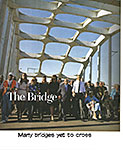
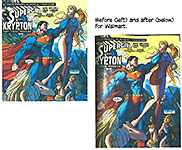
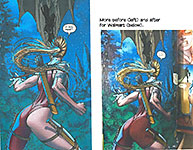
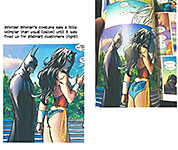
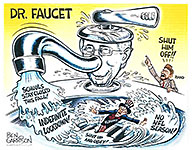
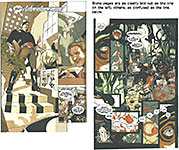
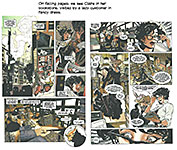
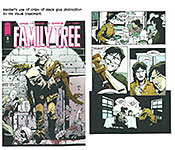
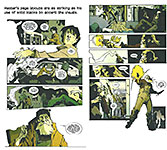

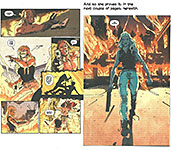
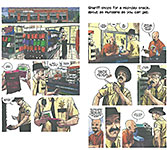


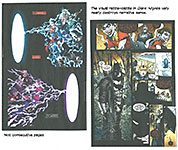
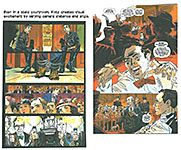
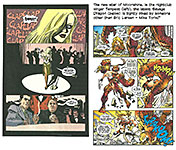
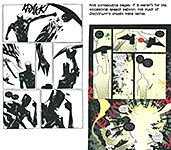
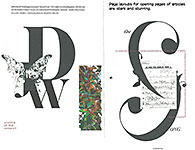
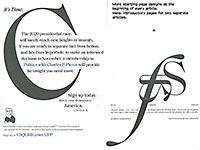

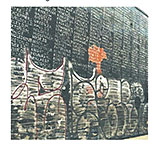
1.jpg)
2.jpg)
3.jpg)
4.jpg)
5.jpg)
6.jpg)
1.jpg)
2.jpg)
3.jpg)
4.jpg)
5.jpg)
6.jpg)
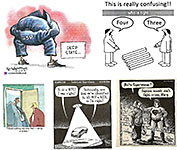
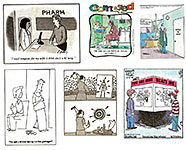
7.jpg)
8.jpg)
9.jpg)
10.jpg)
11.jpg)
12.jpg)
13.jpg)
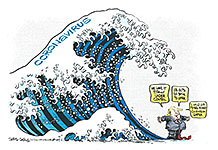
1.jpg)
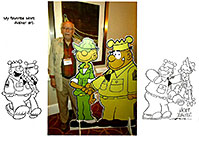
2.jpg)
3.jpg)
4.jpg)
5.jpg)
6.jpg)
7.jpg)
